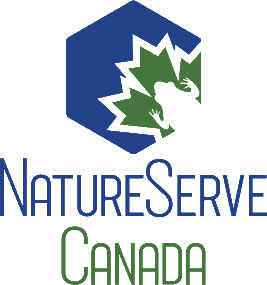|
|
|
|
|
|
|
|
|
|
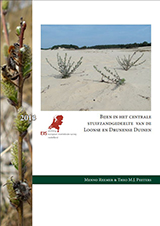 |
|
Reemer, M. & T. Peeters, 2013
Bijen in het centrale stuifzandgedeelte van de Loonse en Drunense Duinen
EIS2013-08, EIS Kenniscentrum Insecten, Leiden
De bijenfauna van het centrale stuifzandgedeelte van de Loonse en Drunense Duinen is in 2006 geïnventariseerd door EIS-Nederland. Sindsdien zijn hier in het kader van het LIFE-project Sand Dynamics in Inland Dunes diverse maatregelen uitgevoerd om het dynamiek van het stuifzand te herstellen, zoals grootschalige boskap, plagwerkzaamheden en schapenbegrazing. In 2013 heeft EIS in opdracht van Natuurmonumenten de inventarisatie herhaald, om zicht te krijgen op de effecten van de maatregelen op de bijenfauna. Deze rapportage doet verslag van de resultaten van de inventarisatie en vergelijkt deze met de resultaten uit 2006, alsmede met die van een eerdere inventarisatie in 1999/2000.
|
|
Downloaden |
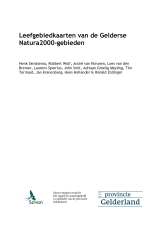 |
|
Henk Sierdsema, Robbert Wolf, André van Kleunen, Loes van den Bremer, Laurens Sparrius, John Smit, Adriaan Gmelig Meyling, Tim Termaat, Jan Kranenbarg, Hans Hollander & Ronald Zollinger 2015
Leefgebiedkaarten van de Gelderse Natura2000-gebieden.
SOVON 2015/67, SOVON Vogelonderzoek Nederland, Nijmegen 54 pp, plus bijlagen
De provincie Gelderland heeft verzocht om leefgebiedkaarten op te stellen per Gelders Natura 2000 gebied, voor alle soorten waarvoor voor het betreffende gebied instandhoudingsdoelen gelden conform het aanwijzingsbesluit. De leefgebiedenkaarten gelden alleen voor de in het aanwijzingsbesluit opgenomen functie(s) voor de soort (zie bijlage 1). Het betreft geschikt leefgebied op basis van terreinkenmerken, onderverdeeld in de categorieën bezet en mogelijk bezet leefgebied op basis van verspreidingsgegevens. Vanuit deze Natura 2000 leefgebieden is tevens verzocht om voor de soorten waarvoor dat aan de orde is stikstofgevoelig PAS leefgebieden af te bakenen. De afbakening hiervan en methodiek hiervoor is gebaseerd op de beschrijvingen in de herstelstrategieën die in het kader van de PAS voor deze leefgebieden zijn opgesteld.
Voor de begrenzing van de Natura 2000 leefgebieden is een combinatie van habitatgeschiktheidkaarten (HSI, Habitat Suitability Index) en recente verspreidingsinformatie gebruikt. De HSI-kaarten geven aan waar op basis van omgevingskenmerken waarschijnlijk geschikt habitat voorkomt voor de betreffende soort. Deze HSI-kaarten worden vervolgens gecombineerd met verspreidingsinformatie om aan te geven waar het voorkomen actueel bekend is (bezet leefgebied).
Voor de begrenzing van de PAS leefgebieden is per leefgebiedtype (LG01 tot LG14) eerst afgebakend in welke terreingedeelten de terreinkenmerken overeenkomen met de beschrijving uit de herstelstrategie. Daarna is onderzocht in welke delen van dit potentiele PAS leefgebied geschikt leefgebied aanwezig is voor de soorten die in de herstelstrategie bij het betreffende LG-type worden genoemd. Het gaat daarbij alleen om delen van Natura 2000 gebieden waarin voor de betreffende soort een instandhoudingsdoelstelling geldt. De combinatie van potentieel PAS leefgebied en geschikt leefgebied van relevante soorten levert zo de afbakening van een PAS leefgebiedtype op. Gedeelten hiervan waarvoor van geen van de relevant soorten is vastgesteld dat het om bezet leefgebied gaat, worden als zoekgebied voor he PAS leefgebiedtype aangeduid.
|
|
Downloaden |
|
|
|
|
|
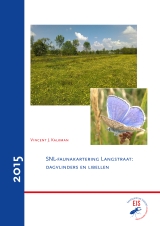 |
|
Kalkman, V.J. 2015
SNL-faunakartering Langstraat: Dagvlinders en libellen
EIS2015-015, EIS Kenniscentrum Insecten, Leiden 16 pp, plus bijlagen
In 2014 en 2015 heeft EIS Kenniscentrum Insecten een gebiedsdekkende karteringen uitgevoerd van dagvlinders, libellen en sprinkhanen in verschillende gebieden van Staatsbosbeheer. Dit gebeurde in opdracht van Staatsbosbeheer, in het kader van het Subsidiestelsel Natuur en Landschap (SNL). Deze deelrapportage geeft de resultaten van de kartering van het object Langstraat van kavel NbrP 2-6 in de provincie Noord-Brabant Het gebied is in 2014 en 2015 in de periode half mei en half augustus twaalf maal bezocht voor dagvlinders, libellen en sprinkhanen. Van de hokken met faunarijke graslanden is 60% van de hokken tweemaal bezocht en 26% eenmaal bezocht. Van de overige hokken is 92% tweemaal bezocht en 6% eenmaal. In totaal zijn 20 soorten dagvlinders, 28 libellensoorten en 13 soorten sprinkhanen waargenomen. Van deze soorten staat alleen het groot dikkopje op de Rode lijst.
|
|
Niet openbaar |
|
|
|
|
|
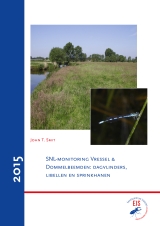 |
|
Smit, J.T. 2015
SNL-faunakartering Vressel & Dommelbeemden: Dagvlinders, libellen en sprinkhanen
EIS2015-014, EIS Kenniscentrum Insecten, Leiden 25 pp, plus bijlagen In 2014 en 2015 heeft EIS Kenniscentrum Insecten een gebiedsdekkende karteringen uitgevoerd van dagvlinders, libellen en sprinkhanen in verschillende gebieden van Staatsbosbeheer. Dit gebeurde in opdracht van Staatsbosbeheer, in het kader van het Subsidiestelsel Natuur en Landschap (SNL). Deze deelrapportage geeft de resultaten van de kartering van de objecten Dommelbeemden en Vressel van kavel NbrP 2-7 in de provincie Noord-Brabant. De gebieden zijn tussen half mei en eind augustus negentien maal bezocht voor dagvlinders,libellen en sprinkhanen. Van de Dommelbeemden is van de hokken met faunarijke graslanden 71% van de hokken tweemaal bezocht en 26% eenmaal bezocht. Van de overige hokken is 96% tweemaal bezocht en 2% eenmaal. Van Vressel is van de hokken met faunarijke graslanden 100% van de hokken tweemaal bezocht. Van de overige hokken voor dagvlinders en libellen is 91% tweemaal bezocht en 2% eenmaal, en van de overige hokken voor dagvlinders en sprinkhanen is 100% tweemaal bezocht. In totaal zijn 25 soorten dagvlinders, 36 libellensoorten en 16 soorten sprinkhanen waargenomen. Daarvan staan het bruin blauwtje, het groot dikkopje, de speerwaterjuffer, de venwitsnuitlibel en de zompsprinkhaan op de Rode Lijst.
|
|
Niet openbaar |
|
|
|
|
|
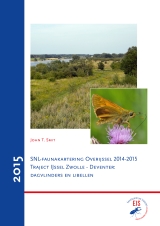 |
|
Smit, J.T. 2015
SNL-faunakartering Overijssel 2014-2015, Traject IJssel Zwolle-Deventer: Dagvlinders en libellen
EIS2015-013, EIS Kenniscentrum Insecten, Leiden 19 pp, plus bijlagen
In 2014 en 2015 heeft EIS Kenniscentrum Insecten een gebiedsdekkende karteringen uitgevoerd van dagvlinders, libellen en sprinkhanen in verschillende gebieden van Staatsbosbeheer. Dit gebeurde in opdracht van Staatsbosbeheer, in het kader van het Subsidiestelsel Natuur en Landschap (SNL). Deze deelrapportage geeft de resultaten van de kartering van het traject IJssel Zwolle-Deventer van kavel OVP 2-1 in de provincie Overijssel. Deze omvat de objecten (van noord naar zuid): Oldeneel, Windesheim, Molenpolder Oost, Wijhe buitenwaarden, Fortmmond, Duursche waarden, Hengforder waarden en Nijendal. De gebieden zijn tussen half mei en half augustus vierentwintig maal bezocht voor dagvlinders en libellen. Van de hokken met faunarijke graslanden is 64% van de hokken tweemaal bezocht en 25% eenmaal bezocht. Van de overige hokken is 92% tweemaal bezocht en 7% eenmaal. In totaal zijn 24 soorten dagvlinders, en 33 libellensoorten waargenomen. Daarvan staan het bruinblauwtje, het groot dikkopje en de gevlekte witsnuitlibel op de Rode lijst.
|
|
Niet openbaar |
|
|
|
|
|
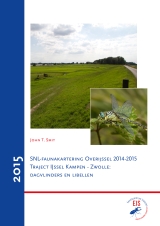 |
|
Smit, J.T. 2015
SNL-faunakartering Overijssel 2014-2015, Traject IJssel Kampen-Zwolle: Dagvlinders en libellen
EIS2015-012, EIS Kenniscentrum Insecten, Leiden 15 pp, + bijlagen
In 2014 en 2015 heeft EIS Kenniscentrum Insecten een gebiedsdekkende karteringen uitgevoerd van dagvlinders, libellen en sprinkhanen in verschillende gebieden van Staatsbosbeheer. Dit gebeurde in opdracht van Staatsbosbeheer, in het kader van het Subsidiestelsel Natuur en Landschap (SNL). Deze deelrapportage geeft de resultaten van de kartering van het traject IJssel Kampen-Zwolle van kavel OVP 2-1 in de provincie Overijssel. Deze omvat de objecten Zalk-Wilsum en Engelse werk. De gebieden zijn tussen half mei en half augustus vijftien maal bezocht voor dagvlinders en libellen. Van de hokken met faunarijke graslanden is 70% van de hokken tweemaal bezocht en 22% eenmaal bezocht. Van de overige hokken is 89% tweemaal bezocht en 9% eenmaal. In totaal zijn 18 soorten dagvlinders en 25 libellensoorten waargenomen. Daarvan staat alleen het groot dikkopje op de Rode Lijst.
|
|
Niet openbaar |
|
|
|
|
|
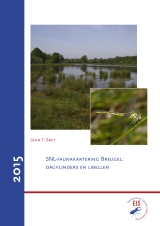
|
|
Smit, J.T. 2015
SNL-faunakartering Breugel: Dagvlinders en libellen
EIS2015-011, EIS Kenniscentrum Insecten, Leiden 16 pp + bijlagen
In 2014 en 2015 heeft EIS Kenniscentrum Insecten een gebiedsdekkende karteringen uitgevoerd van dagvlinders, libellen en sprinkhanen in verschillende gebieden van Staatsbosbeheer. Dit gebeurde in opdracht van Staatsbosbeheer, in het kader van het Subsidiestelsel Natuur en Landschap (SNL). Deze deelrapportage geeft de resultaten van de kartering van het object Breugel van kavel NbrP 2-7 in de provincie Noord-Brabant. De gebieden zijn tussen half mei en half augustus zeventien maal bezocht voor dagvlinders en libellen. Sprinkhanen zijn niet specifiek onderzocht, maar aangetroffen Rode Lijst soorten zijn wel genoteerd. Van de hokken met faunarijke graslanden is 66% van de hokken tweemaal bezocht en 18% eenmaal bezocht. Van de overige hokken is 92% tweemaal bezocht en 6% eenmaal. In totaal zijn 23 soorten dagvlinders, 31 libellensoorten en 4 soorten sprinkhanen waargenomen. Daarvan staan alleen het groot dikkopje en de zompsprinkhaan op
de Rode Lijst.
|
|
Niet openbaar |
|
|
|
|
|
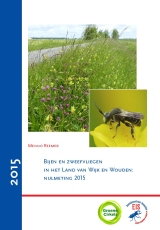 |
|
Reemer, M. 2015
Bijen en zweefvliegen in het land van Wijk en Wouden: nulmeting 2015
EIS-2015-010, EIS Kenniscentrum Insecten, Leiden, 66 pp.
In 2013 is het project Bijenlandschap opgestart in het Land van Wijk en Wouden, deregio rond Leiden, Alphen aan den Rijn en Zoetermeer in Zuid-Holland. Doel van hetproject is het vergroten van de bloemen- en bijenrijkdom, teneinde de biodiversiteit,bestuiving en landschapsbeleving te vergroten. Vele partijen in de regio nemen hiertoemaatregelen in inrichting en beheer. Om te onderzoeken of deze maatregelen hetgewenste effect hebben op de wilde bijenfauna, wordt een monitoring uitgevoerd.In 2015 is de eerste inventarisatie (nulmeting) uitgevoerd en in 2018 wordt deze herhaald.De huidige rapportage bespreekt de resultaten van de nulmeting.In 2015 zijn 12 gebieden onderzocht, waarvan sommige zijn opgedeeld in deelgebieden.Alle gebieden zijn drie maal bezocht, in vroeg voorjaar, laat voorjaar enzomer. Ook zweefvliegen, net als bijen belangrijke bestuivers, zijn in de monitoringmeegenomen.In totaal zijn in 2015 in het Land van Wijk en Wouden 71 soorten bijen en 83 soortenzweefvliegen gevonden. Hier zijn verschillende bijzondere soorten bij, die inhet westen van het land zeldzaam zijn of zelfs op de Nederlandse Rode Lijst staan,zoals de weidebij Andrena gravida, de asbij Andrena cineraria, de distelbehangersbijMegachile ligniseca, de kleine tuinmaskerbij Hylaeus pictipes en de gewone tubebijStelis breviuscula.De resultaten worden per gebied besproken. Adviezen voor inrichting en beheerworden slechts beperkt gegeven, omdat hierin vaak al is voorzien door de Bijenhelpdeskbinnen het project Groene Cirkels. |
|
Downloaden |
|
|
|
|
|
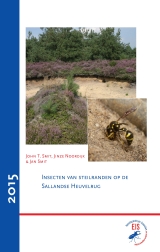 |
|
Smit, J.T., J. Noordijk & J. Smit 2015
Insecten van steilranden op de Sallandse Heuvelrug
EIS-2015-08, EIS Kenniscentrum Insecten en andere ongewervelden, Leiden, 16 pp.
Het gaat slecht met de heidefauna. Het systeem heeft te kampen met een verstoord evenwicht van de voedingsstoffen. Hierdoor worden planten minder aantrekkelijk voor veel insecten. Het gevolg is dat deze dieren en insecteneters het moeilijk hebben en zelfs aan het verdwijnen zijn. Om deze achteruitgang te remmen heeft Natuurmonumenten op de Sallandse Heuvelrug diverse maatregelen uitgevoerd ten behoeve van insecten, waaronder het aanleggen van een groot aantal steilrandjes voor extra nestgelegeheid voor onder andere bijen en graafwespen.
EIS Kenniscentrum Insecten heeft zes van deze steilranden in 2015 onderzocht, niet alleen op bijen maar voor het eerst ook op graafwespen en diverse andere insectengroepen. In totaal zijn er 73 soorten insecten aangetroffen, waaronder 15 soorten bijen en 14 soorten graafwespen. Hieronder zijn diverse zeldzame tot zeer zeldzame soorten aangetroffen. De spectaculairste vondst was die van de gele tubebij Stelis signata, Rode Lijstcategorie ernstig bedreigd.
Al met al geven de steilranden een bijzondere soortensamenstelling: nestgelegenheid van bijen en wespen die hun voedsel grotendeels van elders op de heide halen, bijbehorende broedparasieten en predatoren, generalistische predatoren als zandloopkevers en mierenleeuwen en warmteminnende herbivoren zoals doorntjes en blauwvleugelsprinkhaan. Er ontstaat zo een uitgebreide soortengemeenschap die eigenlijk alleen in deze samenstelling te vinden is bij grote kale plekken zand. De steilranden zijn dus zeer waardevolle insectenbiotopen die elders op de heide niet te vinden zijn. |
|
Downloaden |
|
|
|
|
|
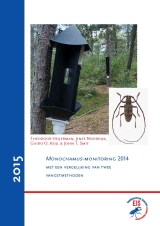
|
|
Heijerman, Th., J. Noordijk, G.O. Keijl & J.T. Smit 2015
Monochamus-monitoring 2014 met een vergelijking van twee vangstmethoden
EIS-2015-02, EIS Kenniscentrum Insecten en andere ongewervelden, Leiden, 21 pp. + bijlagen
Dit rapport behandelt de onderzoeksopzet en de resultaten van het zesde jaarwaarin het voorkomen van boktorren van het genus Monochamus is geïnventariseerd.Naar aanleiding van enkele vondsten van de boktor in het noordelijk deel van België werden dit jaar dennenbossen langs de grens met dit land bemonsterd.Er werden azijnzuurvallen opgehangen in Zeeuws-Vlaanderen, Noord-Brabant,Midden-Limburg en Zuid-Limburg. Er werden geen Monochamus-soortengevangen op deze locaties en het is niet aannemelijk dat er een populatie van Monochamus in de onderzochte bossen langs de Belgische grens is.De NVWA heeft ook in 2014 azijnzuurvallen opgehangen op risicolocaties, veelal bedrijven waar veel verpakkingshout wordt gebruikt. Ook hier zijn geen boktorren van het genus Monochamus gevangen. Er werden echter wel drie potentieel invasieve exoten gevangen: Trichoferus cf campestris (Cerambycidae), Berginus tamarisci (Mycetophagidae) en Cryptophilus obliteratus (Erotylidae). De eerste soort is nuvoor het tweede opeenvolgende jaar in Nederland gevonden tijdens de monitoring;de andere twee soorten zijn nog niet eerder voor Nederland gemeld.Daarnaast heeft in de bekende populatie van Monochamus galloprovincialis in de Schoorlse Duinen een vergelijkend onderzoek plaatsgevonden met twee valtypen. De conclusie hieruit is dat het gebruik van a-pineen als extra lokstof bij de vallenzeer is aan te raden, omdat deze lokstof resulteerde in hogere vangsten van M. galloprovincialis en tevens kan zorgen voor een grotere aantrekking op andere Monochamus-soorten dan vallen waarin alleen het gebruikelijke Galloprotect 2D hangt, dat specifiek is ontwikkeld voor het lokken van M. galloprovincialis. Door deze bemonstering werd tevens duidelijk dat de populatie in de Schoorlse Duinen een aanzienlijke omvang heeft, want er werden in zes vallen maar liefst 214 individuen gevangen. |
|
Downloaden |
|
|
|
|
|
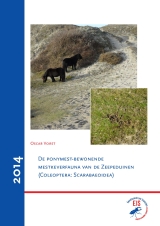
|
|
Vorst, O., 2014
De ponymest-bewonende mestkeverfauna van de Zeepeduinen (Coleoptera: Scarabaeoidea)
EIS 2014-23, EIS Kenniscentrum Insecten en andere ongewervelden, Leiden, 18 pp. + bijlages
Dit rapport beschrijft een onderzoek naar de ponymest-bewonende keverfauna van de Zeepeduinen. Het onderzoeksgebied is een afwisselend duinterrein op Schouwen- Duivenland, dat al enkele decennia jaarrond begraasd wordt door een kudde van circa 100 Shetlandpony's. Aanleiding vormde de bezorgdheid over mogelijk negatieve effecten van de preventieve ontworming van de pony's op de mestbewonende fauna. De hier gepresenteerde resultaten dienen primair als nulmeting om eventuele veranderingen in de mestkeverfauna na beëindiging van de behandeling te kunnen monitoren.
In totaal werden 6469 mestbewonende bladsprietkevers, behorend tot 18 soorten, waargenomen. De mestkeverfauna lijkt daarmee redelijk divers en min of meer in overeenstemming met wat van een dergelijk terrein verwacht mag worden. Het merendeel (14) van deze soorten is als weinig kieskeurig en wijdverbreid te beschouwen. Enkele ook aan de kust verbreide soorten werden niet waargenomen.
Wat opvalt is dat de frequentieverdeling opvallend scheef is, met één dominante soort (Aphodius sphacelatus, 89%) en relatief veel soorten die in slechts weinig exemplaren werden verzameld.
|
|
Downloaden
|
|
|
|
|
|
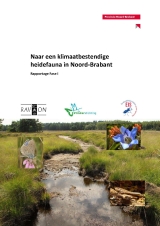
|
|
Wallis de Vries, M.F., J. Noordijk & R. Zollinger, 2014
Naar een klimaatbestendige heidefauna in Noord-Brabant: rapportage fase I
Rapport VS2014.028, De Vlinderstichting / Stichting RAVON / EIS-Kenniscentrum Insecten, Wageningen, 48 pp.
Klimaatextremen worden met de voortschrijdende klimaatverandering naar verwachting steeds gewoner. Dat betekent meer kans op zowel zomerdroogte als zware regenval. Voor kenmerkende diersoorten van de natte heide kan dat een probleem zijn omdat hun leefgebied zich juist op de grens van nat en droog bevindt en door vergrassing met pijpenstrootje in de knel komt. Bij natuurherstel door vernatting kan dit extra problematisch zijn wanneer er hogerop geen geschikt leefgebied te vinden is. In Noord-Brabant is daarom afgelopen jaar in acht grotere heidegebieden gewerkt aan kleinschalige herstelmaatregelen over de hele hoogte gradiënt van nat naar droog.
In Fase I van dit project is de kennis over het voorkomen van de aandachtsoorten vertaald in uitvoeringsplannen. In de acht projectgebieden van Staatsbosbeheer, Natuurmonumenten, Brabants Landschap en de gemeente Valkenswaard zijn op verschillende manieren kleinschalige beheermaatregelen uitgevoerd van nat naar droog en is een start gemaakt met de monitoring.
|
|
Downloaden
|
|
|
|
|
|
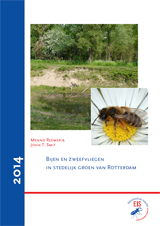 |
|
Reemer, M. & J.T. Smit, 2014
Bijen en zweefvliegen in stedelijk groen van Rotterdam
EIS 2014-21, EIS Kenniscentrum Insecten en andere ongewervelden, Leiden, 46 pp. + bijlagen
Op verzoek van Bureau Stadsnatuur Rotterdam heeft EIS Kenniscentrum Insecten in 2014 een inventarisatie uitgevoerd van de bijen en zweefvliegen op 13 locaties in Rotterdam. Elke locatie is drie maal bezocht: in april, mei en juli. Deze inventarisatie geeft een indruk van de Rotterdamse bijenfauna, en geeft bovendien inzicht in de mogelijkheden om met aanpassingen in inrichting en beheer iets voor de bijen- en andere bestuiversfauna te betekenen.
In totaal zijn 61 soorten bijen en 75 soorten zweefvliegen gevonden. De locatie met de meeste bijensoorten is de Stoopweg (33 soorten), gevolgd door het Eiland van Brienenoord (27), Jachthaven IJsselmonde (24) en de Spoortuin (24). De Stoopweg is ook wat zweefvliegen betreft de rijkste locatie met 39 soorten, op de voet gevolgd door Kralingse Bos vistrap en Ommoordse Veld met elk 38 soorten.
Per locatie worden de resultaten besproken en worden aanbevelingen gegeven om de bijen- en zweefvliegenfauna te stimuleren. In het hoofdstuk Aanbevelingen worden deze samengevat. Het rapport besluit met enkele bijlagen met informatie over bijvriendelijk maaibeheer, aanwijzingen voor bouw en plaatsing van bijenhotels en de aanleg van van nestelhopen, -wanden en -dijkjes. |
|
Downloaden |
|
|
|
|
|
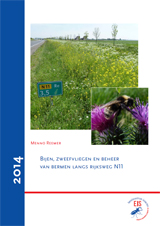 |
|
Reemer, M., 2014
Bijen, zweefvliegen en beheer van bermen langs rijksweg N11
EIS 2014-20, EIS Kenniscentrum Insecten en andere ongewervelden, Leiden, 28 pp. + bijlagen
In 2014 heeft EIS Kenniscentrum Insecten een inventarisatie uitgevoerd van bijen, zweefvliegen en dagvlinders in wegbermen van Rijksweg N11 tussen Leiden en Hazerswoude-Rijndijk. De resultaten worden gebruikt bij het opstellen van adviezen voor een bijvriendelijker beheer van de bermen. Het onderzoek is zo opgezet dat dit in de toekomst op dezelfde wijze herhaald kan worden, zodat de effecten van gewijzigd beheer op de bijenfauna zichtbaar gemaakt kunnen worden.
In totaal zijn 27 soorten bijen, 44 soorten zweefvliegen en 13 soorten dagvlinders gevonden. In het rapport wordt het voorkomen van de soorten geanalyseerd. Voorts worden enkele aanbevelingen gegeven voor het creëren van meer nestelgelegenheid.
Als 'toegift' is in dit rapport een hoofdstuk opgenomen over de bijvriendelijke benutting van geluidsschermen langs snelwegen. Er worden enkele algemene voorwaarden geschetst, waarma de situatie rond de geluidsschermen bij Hazerswoude-Rijndijk (N11) en de Willem van der Madeweg bij Leiden (A4) nader besproken wordt. |
|
Downloaden |
|
|
|
|
|
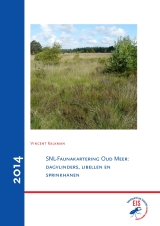 |
|
Kalkman, V.J., 2014
SNL-Faunakartering Oud Meer: dagvlinders, libellen en sprinkhanen
EIS 2014-16, EIS Kenniscentrum Insecten en andere ongewervelden, Leiden, 16 pp. + bijlagen
In 2014 heeft EIS Kenniscentrum Insecten een gebiedsdekkende karteringen uitgevoerd van dagvlinders, libellen en sprinkhanen in verschillende gebieden van Staatsbosbeheer. Dit gebeurde in opdracht van Staatsbosbeheer, in het kader van het Subsidiestelsel Natuur en Landschap (SNL). Dit rapport heeft betrekking op het gebied Oud Meer een gebied wat Staatsbosbeheer in erfpacht en beheer heeft van de gemeente Son en Breugel. Voor dagvlinder en libellen zijn 96 % van de hokken tweemaal en 4 % eenmaal bezocht. Voor sprinkhanen zijn 83 % van de hokken tweemaal en 17 % eenmaal bezocht. In totaal zijn 13 soorten dagvlinders, 22 libellensoorten en 11 soorten sprinkhanen waargenomen. Daarvan staan vier soorten op de Rode lijst: groot dikkopje, gevlekte witsnuitlibel (Habitatrichtlijnsoort), moerassprinkhaan en veldkrekel.
|
|
Niet openbaar |
|
|
|
|
|
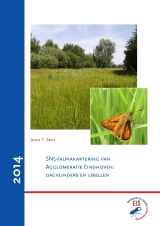 |
|
Smit, J.T., 2014
SNL-Faunakartering van Agglomeratie Eindhoven: dagvlinders, libellen en sprinkhanen
EIS 2014-15, EIS Kenniscentrum Insecten en andere ongewervelden, Leiden, 20 pp. + bijlagen
In 2014 heeft EIS Kenniscentrum Insecten een gebiedsdekkende karteringen uitgevoerd van dagvlinders, libellen en sprinkhanen in verschillende gebieden van Staatsbosbeheer. Dit gebeurde in opdracht van Staatsbosbeheer, in het kader van het Subsidiestelsel Natuur en Landschap (SNL). Deze deelrapportage geeft de resultaten van de kartering van het object agglomeratie Eindhoven van kavel NbrP 2-7 in de provincie Noord-Brabant. De gebieden zijn tussen half mei en half augustus acht maal bezocht voor dagvlinders
en libellen. Van de hokken met faunarijke graslanden is 66% van de hokken tweemaal bezocht en 31% eenmaal bezocht. Van de overige hokken is 83% tweemaal bezocht en 10% eenmaal. In totaal zijn 22 soorten dagvlinders, 20 libellensoorten en 3 soorten sprinkhanen waargenomen. Daarvan staan alleen het groot dikkopje, de moerassprinkhaan en de zompsprinkhaan op de Rode lijst.
|
|
Niet openbaar |
|
|
|
|
|
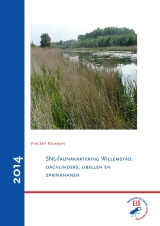 |
|
Kalkman, V.J., 2014
SNL-Faunakartering in Willemstad: dagvlinders, libellen en sprinkhanen
EIS 2014-14, EIS Kenniscentrum Insecten en andere ongewervelden, Leiden, 14 pp. + bijlagen
In 2014 heeft EIS Kenniscentrum Insecten een gebiedsdekkende karteringen uitgevoerd van dagvlinders, libellen en sprinkhanen in verschillende gebieden van Staatsbosbeheer. Dit gebeurde in opdracht van Staatsbosbeheer, in het kader van het Subsidiestelsel Natuur en Landschap (SNL). Dit rapport heeft betrekking op de gebieden rondom Willemstad (Noord-Brabant). In totaal is 82% van de hokken tweemaal en 18% eenmaal bezocht. In totaal zijn 14 soorten dagvlinders, 17 libellensoorten en negen soorten sprinkhanen waargenomen. Hieronder bevinden zich geen soorten van de rode lijst.
|
|
Niet openbaar |
|
|
|
|
|
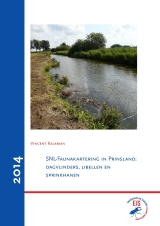 |
|
Kalkman, V.J., 2014
SNL-Faunakartering in Prinsland: dagvlinders, libellen en sprinkhanen
EIS 2014-13, EIS Kenniscentrum Insecten en andere ongewervelden, Leiden, 14 pp. + bijlagen
In 2014 heeft EIS Kenniscentrum Insecten een gebiedsdekkende karteringen uitgevoerd van dagvlinders, libellen en sprinkhanen in verschillende gebieden van Staatsbosbeheer. Dit gebeurde in opdracht van Staatsbosbeheer, in het kader van het Subsidiestelsel Natuur en Landschap (SNL). Dit rapport heeft betrekking op de gebieden rondom Prinsland. Van de hokken met faunarijke graslanden is 84% van de hokken tweemaal bezocht en 9% eenmaal bezocht. Van de overige hokken is 88% tweemaal bezocht en 12% eenmaal. In totaal zijn 14 soorten dagvlinders, 11 libellensoorten en 6 soorten sprinkhanen waargenomen. Daarvan staat alleen groot dikkopje op de Rode lijst.
|
|
Niet openbaar |
|
|
|
|
|
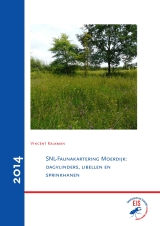 |
|
Kalkman, V.J., 2014
SNL-Faunakartering Moerdijk: dagvlinders, libellen en sprinkhanen
EIS 2014-12, EIS Kenniscentrum Insecten en andere ongewervelden, Leiden, 14 pp. + bijlagen
In 2014 heeft EIS Kenniscentrum Insecten een gebiedsdekkende karteringen uitgevoerd van dagvlinders, libellen en sprinkhanen in verschillende gebieden van Staatsbosbeheer. Dit gebeurde in opdracht van Staatsbosbeheer, in het kader van het Subsidiestelsel Natuur en Landschap (SNL). Dit rapport heeft betrekking op de gebieden rondom Moerdijk. Van de hokken met faunarijke graslanden is 64% van de hokken tweemaal bezocht en 28% eenmaal. Van de overige hokken is 100% tweemaal bezocht. In totaal zijn 18 soorten dagvlinders, 12 libellensoorten en 9 soorten sprinkhanen waargenomen. Daarvan staan het bruin blauwtje en de sikkelsprinkhaan op de Rode lijst.
|
|
Niet openbaar |
|
|
|
|
|
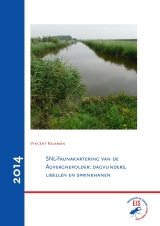 |
|
Kalkman, V.J., 2014
SNL-Faunakartering van de Auvergnepolder: dagvlinders, libellen en sprinkhanen
EIS 2014-11, EIS Kenniscentrum Insecten en andere ongewervelden, Leiden, 14 pp. + bijlagen
In 2014 heeft EIS Kenniscentrum Insecten een gebiedsdekkende karteringen uitgevoerdvan dagvlinders, libellen en sprinkhanen in verschillende gebieden vanStaatsbosbeheer. Dit gebeurde in opdracht van Staatsbosbeheer, in het kader vanhet Subsidiestelsel Natuur en Landschap (SNL).Dit rapport heeft betrekking op de in Noord-Brabant gelegen Auvergnepolder. Degebieden zijn tussen mei en augustus driemaal bezocht voor dagvlinders, libellenen sprinkhanen.Van de hokken met faunarijke graslanden is 70% van de hokken tweemaal bezochten 27% eenmaal. Van de overige hokken is 47% tweemaal bezocht en 53%eenmaal.In totaal zijn 14 soorten dagvlinders, 8 libellensoorten en 7 soorten sprinkhanenwaargenomen. Daarvan staat alleen het groot dikkopje op de Rode lijst. |
|
Niet openbaar |
|
|
|
|
|
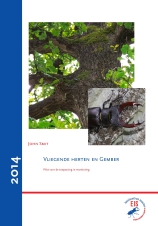 |
|
Smit, J.T., 2014
Vliegende herten en gember. Pilot voor de toepassing in monitoring
EIS2014-09, EIS Kenniscentrum Insecten en andere ongewervelden, Leiden, 11 pp. + bijlagen
In 2014 is in opdracht van de provincie Gelderland een pilot uitgevoerd naar de bruikbaarheidvan gember als lokstof in zogenaamde flight-interception-traps als aanvullendemethode voor de monitoring van de staat van instandhouding van het vliegendhert in Nederland.Aanleiding hiervoor was de publicatie van een artikel van een Engels team waarin geconcludeerdwerd dat flight-interception-traps met gember als lokstof geschikt zijn omvliegende herten te vangen en dat gember zowel mannetjes als vrouwtje in vergelijkbareaantallen aantrekt (Harvey et al. 2011).
De conclusie is dat gember niet werkt als lokstof voor vliegende herten en datde monitoring van de staat van instandhouding in het kader van het NEM het bestevoortgezet kan worden zoals die reeds jaren gebruikelijk is, namelijk met behulp vanvrijwillgers, recreanten en omwonenden door blijvend aandacht te vragen voor dezesoort in de media, vergezeld van een oproep tot het doorgeven van waarnemingen.
|
|
Downloaden |
|
|
|
|
|
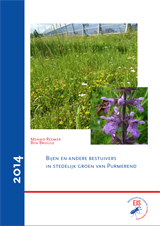 |
|
Reemer, M. & B. Brugge, 2014
Bijen en andere bestuivers in stedelijk groen van Purmerend
EIS 2014-08, EIS Kenniscentrum Insecten en andere ongewervelden, Leiden, 38 pp. + bijlagen
In 2014 heeft EIS Kenniscentrum Insecten een inventarisatie uitgevoerd van de bijen en zweefvliegenfauna op 10 locaties in Purmerend. Aan de hand van de resultaten kunnen waar wenselijk wijzigingen in het stedelijk groenbeheer worden doorgevoerd om de bestuiversfauna te stimuleren. Door de inventarisatie op een gestandaardiseerde wijze uit te voeren, kan deze over enkele jaren herhaald worden, zodat de resultaten tussen verschillende jaren vergelijkbaar zijn. Effecten van eventuele wijzigingen in het beheer op de bijen- en zweefvliegenfauna kunnen hiermee inzichtelijk gemaakt worden.
In dit rapport zijn ook gegevens verwerkt van bijen in Purmerend uit de jaren 1940-2013. Deze zijn grotendeels afkomstig uit de collectie van Ben Brugge, entomoloog en inwoner van Purmerend. Een klein deel komt uit het databestand van EIS Kenniscentrum Insecten. Deze historische gegevens worden gebruikt om een completer beeld van de Purmerendse bijenfauna te geven.
In 2014 zijn in Purmerend 42 soorten bijen, 66 soorten zweefvliegen en 16 soorten dagvlinders gevonden. Uit de jaren 1940-2013 zijn nog eens 18 aanvullende bijensoorten bekend, waarmee het totaal uit Purmerend bekend bijensoorten op 60 komt. Onder de aangetroffen soorten zijn geen echte bijzonderheden. Wel zijn er enkele plekken die een relatief rijke bijenfauna hebben, met name de Gorslaan (22 soorten), heemtuin De Dwarsgouw (20 soorten) en A7 Weidevenne (18 soorten). Het beheer van deze plekken is al vrij gunstig voor bijen. Sommige van de minder soortenrijke plekken hebben potentie om tot rijker bijengebied uit te groeien. Dit geldt vooral voor de taluds bij de Nelson Mandelabrug, de stadsparken (Leeghwaterpark en De Uitvlugt) en de twee gebieden in polder De Baanstee. |
|
Downloaden |
|
|
|
|
|
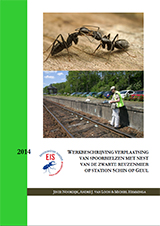 |
|
Noordijk, J., A.J. van Loon & M. Hemminga, 2014
Werkbeschrijving verplaatsing van spoorbielzen met nest van de zwarte reuzenmier op station Schin op Geul
EIS 2014-03, EIS Kenniscentrum Insecten en andere ongewervelden, Leiden, 7 pp.
De bielzen onder de rails langs een perron van de Zuid-Limburgse Stoomtrein Maatschappij (ZLSM) zullen vervangen worden door nieuwe dwarsliggers. De locatie vormt de enige bekende vindplaats van de zwarte reuzenmier Camponotus vagus in Nederland, waarbij de mieren een nest hebben in de bielzen.
De ZLSM en de Provincie Limburg hebben EIS Kenniscentrum Insecten verzocht om de bielzen waarin het nest zich bevindt te markeren, waarna ze verplaatst kunnen worden naar een andere plek in de directe omgeving, in een poging de zwarte reuzenmier te behouden voor ons land.
In dit rapport beschrijven we de vindplaats van het nest, een manier om de bielzen te verplaatsen, en de gewenste uitleglocatie. |
|
Niet openbaar |
|
|
|
|
|
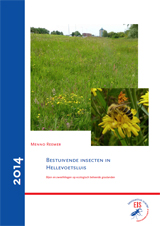 |
|
Reemer, M., 2014
Bestuivende insecten in Hellevoetsluis
EIS 2014-02, EIS Kenniscentrum Insecten en andere ongewervelden, Leiden, 25 pp. + bijlagen
De gemeente Hellevoetsluis voert ecologisch beheer op enkele graslandlocaties. Het gaat om bloemrijke plekken, waarvan het maaibeheer is afgestemd op instandhouding van de plantenrijkdom. Op verzoek van de gemeente Hellevoetsluis heeft EIS Kenniscentrum Insecten in 2013 en 2014 een inventarisatie uitgevoerd van de bijen en zweefvliegen (bestuivende insecten) op drie ecologische beheerde graslandlocaties: Kanaalweg Oost, Kanaalweg West en Kooisteebos.
Eén van de doelen van de inventarisatie was een vergelijking tussen ecologisch beheerd grasland en intensief gemaaid gazon, en tussen ecologisch beheerd grasland en 'ruw gras' (voor definitie zie omschrijving locatie Kanaalweg West). Een ander doel van de inventarisatie was een onderzoek naar mogelijkheden voor verbeteringen in het beheer ten gunste van de bestuiversfauna.
In totaal zijn tijdens de inventarisatie 31 soorten bijen (waarvan zes soorten hommels) en 47 soorten zweefvliegen aangetroffen op de drie onderzoekslocaties. De auteur analyseert het voorkomen van de diverse soorten en besluit met twee hoofdaanbevelingen voor het beheer van de locaties, en enkele specifieke aanbevelingen per locatie. |
|
Downloaden |
|
|
|
|
|
 |
|
Heijerman, Th. & J. Noordijk, 2014
Monochamus-inventarisatie nabij risicolocaties
EIS 2014-04, EIS Kenniscentrum Insecten en andere ongewervelden, Leiden, 17 pp. + bijlagen
Dit verslag rapporteert over het vijfde jaar waarin het voorkomen van boktorren van het genusMonochamus is geïnventariseerd. Deze boktorren kunnen vector zijn voor het dennenhoutaaltje of 'pine wood nematode'. Zowel het dennenhoutaaltje als niet-Europese Monochamus-soorten staan op Europese Fytorichtlijn als quarantaineorganismen en dienen daarom gemonitord te worden.
In 2013 zijn dennenbossen geïnventariseerd die in de nabijheid liggen van bedrijven waar veel verpakkingshout binnenkomt, zogenaamde 'risicolocaties' voor Monochamus en dennenhoutaaltje. Tevens zijn de kevers uit vallen die NVWA óp risicolocaties heeft gehangen gedetermineerd.
In totaal zijn er meer dan 5000 kevers uit de vallen gedetermineerd. Monochamus werd niet gevangen, maar wel zijn er enkele andere exotische keversoorten van belang aangetroffen. Er zijn ook weer enkele inheemse soorten verzameld die nieuw zijn voor een provincie of die als zeldzaam beschouwd worden en sinds geruime tijd niet in Nederland zijn aangetroffen. |
|
Downloaden |
|
|
|
|
|
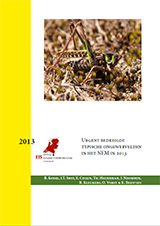 |
|
Koese, B., J.T. Smit, E. Colijn, Th. Heijerman, J. Noordijk, R. Kleukers, O. Vorst & K. Beentjes, 2013
Urgent bedreigde typische ongewervelden in het NEM in 2013
EIS 2013-12, EIS Kenniscentrum Insecten en andere ongewervelden, Leiden, 24 pp. + bijlagen
Elk EU-land heeft, conform de verplichtingen die voortvloeien uit de habitatrichtlijn, de verantwoordelijkheid om te zorgen voor een gunstige staat van instandhouding van de verschillende habitattypen en (bijbehorende) soorten. Eens in de zes jaar rapporteren de lidstaten de staat van instandhouding van de soorten en habitats aan de EU. De afgelopen rapportageperiode liep van 2007-2012. In de voorliggende rapportage worden de gegevens gepresenteerd die verzameld zijn in 2012 en 2013 (met nadruk op 2013) ten behoeve van de rapportage aan de EU over de periode 2013-2018.
Naar alle vier de kevers van de habitatrichtlijn is in 2013 gericht onderzoek gedaan. Voor de vermiljoenkever Cucujus cinnaberinus werd een pilot uitgevoerd om te onderzoeken of de inventarisatie geoptimaliseerd zou kunnen worden met behulp van azijnzuurvallen. Voor de brede geelgerande waterroofkever Dytiscus latissimus werd de PCR-assay voorgezet, waarmee de soort in de toekomst mogelijk met behulp van 'environmental-DNA' (vrij, in het water zwevend DNA van de betreffende soort) gedetecteerd kan worden. Voor de gestreepte waterroofkever Graphoderus bilineatus werd voor het derde achtereenvolgende jaar het meetprogramma voor het trendonderzoek uitgevoerd. Voor het vliegend hert werd in 2013 een gerichte publieksactie uitgevoerd in het Rijk van Nijmegen.
Voor wat betreft de typische soorten is alleen voor de sprinkhanen (wrattenbijter Decticus verrucivorus en kleine wrattenbijterGampsocleis glabra) gericht veldwerk uitgevoerd. |
|
Downloaden |
|
|
|
|
|
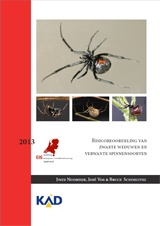 |
|
Noordijk, J., J. Vos & B. Schoelitsz, 2013
Risicobeoordeling van zwarte weduwen en verwante spinnensoorten
EIS 2013-03, EIS-Nederland, Leiden & KAD Wageningen, 34 pp. + bijlagen
Latrodectus-soorten, waaronder zwarte weduwen (L. mactans en L. hesperus) en de roodrugspin (L. hasselti), worden soms versleept vanuit hun natuurlijke areaal naar nieuwe gebieden. Het zijn spinnen met een krachtig gif die een gezondheidsrisico meebrengen voor de mens.
In dit rapport wordt beschreven in hoeverre deze spinnen ook in Nederland (kunnen) voorkomen. In totaal konden tien gedocumenteerde imports worden gevonden (uit de periode 1994-2012), waarbij het tweemaal ging om L. hesperus, eenmaal om L. hasselti en zeven maal om L. hesperus óf L. mactans. Hierbovenop bestaan er veel anekdotische meldingen van imports die suggereren dat Latrodectuswaarschijnlijk minimaal eens per maand wordt ingevoerd.
Er bestaat dus een introductierisico voor Nederland, maar hoe omvangrijk dat in werkelijkheid is kon niet vastgesteld worden. Latrodectus wordt vaak niet gemeld, maar waarschijnlijk simpelweg verwijderd bij een import. De Latrodectus-soorten kunnen in ons land in verwarmde gebouwen waarschijnlijk nakomelingen krijgen. Vestiging vanLatrodectus buiten gebouwen is momenteel onwaarschijnlijk, omdat onze zomers niet warm en droog genoeg zijn. De belangrijkste risicolocaties zijn plekken waar scheepvaartcontainers open worden gemaakt en gebouwen van old-timerhandelaars. |
|
Downloaden |
|
|
|
|
|
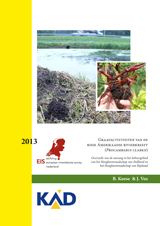 |
|
Koese, B. & J. Vos, 2013
Graafactiviteiten van de de rode Amerikaanse rivierkreeft (Procambarus clarkii). Overzicht van de omvang in het beheergebied van het Hoogheemraadschap van Delfland en het Hoogheemraadschap van Rijnland
EIS 2013-05, EIS-Nederland, Leiden, 26 pp. + bijlagen
Naar aanleiding van enkele recente meldingen van mogelijke graafschade door rode Amerikaanse rivierkreeften (Procambarus clarkii) hebben Stichting EIS-Nederland (EIS) en het Kenniscentrum Dierplagen (KAD) in opdracht van de hoogheemraadschappen Delfland en Rijnland in het najaar van 2012 een inventarisatie uitgevoerd met de volgende doelstellingen:
- Kwantificeren van de omvang van de graafactiviteiten in termen van bereik (afstand tot de oever en waterspiegel) en liters grond;
- Beschrijven van oever (bodemstructuur, type beschoeiing) met en zonder graafschade door kreeften;
- Schatten van de gemaakte en te maken kosten om vergraven oevers te herstellen;
- Indien mogelijk: informatie verzamelen over factoren die het graafgedrag beïnvloeden.
Op in totaal 17 locaties (adressen) werd graafgedrag door rode Amerikaanse rivierkreeften geconstateerd. In totaal werden 79 kreeften uitgegraven, afkomstig uit 48 verschillende holen. In veengrond blijkt een individuele kreeft minimaal 1,26 liter aarde per dag te kunnen verplaatsen. Het maximale grondverzet door kreeften gezamelijk wordt geschat op 30-50 liter aarde per meter oever per jaar.
|
|
Niet openbaar |
|
|
|
|
|
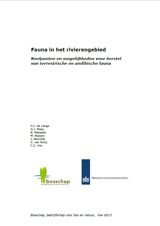 |
|
H.J. de Lange, G.J. Maas, B. Makaske, M. Nijssen, J. Noordijk, S. van Rooij & C.C. Vos, 2013
Fauna in het rivierengebied - Knelpunten en mogelijkheden voor herstel van terrestrische en amfibische fauna
Rapportnummer 2013/OBN175-RI. Directie Agrokennis, Ministerie van Economische Zaken.
Door de huidige inrichting van het rivierengebied zijn de meeste natuurlijke processen sterk beteugeld. De afgelopen decennia zijn veel natuurontwikkelingsprojecten uitgevoerd langs de verschillende riviertakken. Het ontbreekt echter aan een goede onderbouwing waarom bepaalde inrichtingen voor de fauna succesvol zijn en andere niet. Om concrete adviezen te kunnen geven voor natuurontwikkeling, is het noodzakelijk om te begrijpen waarom bepaalde soorten aan het rivierenlandschap zijn gebonden en wat hun huidige knelpunten zijn.
Uit de analyse bleek dat de knelpunten in drie hoofdcategorieën verdeeld kunnen worden: (i) onvoldoende oppervlak van het habitat, (ii) het ontbreken van specifieke habitatcombinaties en (iii) onvoldoende kwaliteit van het habitat. Er zijn drie habitattypen die duidelijk het meest ontbreken in de huidige uiterwaarden. Het gaat om laagdynamische natte zones, plekken met schrale begroeiing en open zandige plekken en moerasbossen. Veel diersoorten hebben meerdere habitats nodig om hun levenscyclus te voltooien. Deze behoefte kan in drie categorieën opgesplitst worden, waartussen overlap kan voorkomen: specifieke habitatcombinaties, hoogwatervrije vluchtplaatsen naast zomerhabitat en verbindingen met binnendijkse gebieden. Daarnaast spelen vermesting en de nog steeds onvoldoende waterkwaliteit van het rivierwater een rol.
Op basis van de geschatte oppervlaktebehoefte en dispersiecapaciteit van de soorten, zijn voor de twee studietrajecten kansenkaarten opgesteld die aangeven op welke locaties de meeste natuurwinst te halen is waardoor stapstenen en sleutelgebieden worden gecreëerd voor de diersoorten van het rivierengebied. |
|
Niet openbaar |
|
|
|
|
|
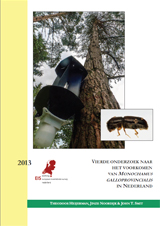 |
|
Heijerman, Th., J. Noordijk & J.T. Smit, 2013
Vierde onderzoek naar het voorkomen van Monochamus galloprovincialis in Nederland
EIS 2013-01, EIS-Nederland, Leiden, 20 pp. + bijlagen
Voor de vierde maal is in opdracht van de NVWA een inventarisatie gehouden naar boktorren van het genus Monochamus en andere xylobionte kevers. Monochamus-soorten zijn vectoren voor het dennenhoutaaltje Bursaphelenchus xylophilus; een exoot die de dennenverwelkings- ziekte kan veroorzaken. Binnen de EU wordt scherp gecontroleerd op deze nematode.
In 2012 werden tien dennenbossen onderzocht: drie op de Veluwe, één in Flevoland en twee in Overijssel, Drenthe en Friesland. Hierbij werd gebruik gemaakt van azijnzuurvallen met feromonen. In totaal werden 1.769 kevers gevangen (waarbij de kortschildkevers niet zijn meegeteld) van 105 taxa.Monochamus galloprovincialis werd in de onderzochte bossen niet aangetroffen, en het lijkt erop dat deze soort maar één populatie elders in Nederland heeft. |
|
Downloaden |
|
|
|
|
|
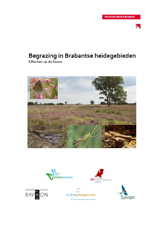 |
|
Wallis de Vries, M.F., J. Noordijk, H. Sierdsema, R. Zollinger, J.T. Smit & M. Nijssen, 2013
Begrazing in Brabantse heidegebieden - Effecten op de fauna
De Vlinderstichting, Wageningen / EIS-Nederland, Leiden / SOVON Vogelonderzoek, Stichting RAVON en Stichting Bargerveen, Nijmegen, 121 pp. + bijlagen
Heidelandschappen herbergen een belangrijk deel van de biodiversiteit in Nederland. Voor het behoud van gevarieerde heidelandschappen wordt in het terreinbeheer veelal gebruik gemaakt van begrazing. In dit rapport zijn de effecten van begrazing op kenmerkende diersoorten van de heide in Noord-Brabant onderzocht. Op basis daarvan zijn aanbevelingen voor het beheer opgesteld. In het veldonderzoek zijn op de Strabrechtse Heide, Spinsterbergen en Braakhuizensche Heide zowel natte heide als droge heide, variërend van onbegraasd tot zeer intensief begraasd, onderzocht op de aantallen voorkomende levendbarende hagedissen en dagvlinders, sprinkhanen, bijen, zweefvliegen, mieren, zandloopkevers, de heidecicade en enkele spinnensoorten. Met name op de droge heide liet begrazing positieve effecten zien op de insectenfauna en werden bij een zeer intensief begrazingsregiem zelfs enkele bijzondere warmteminnende soorten gevonden. |
|
Downloaden |
|
|
|
|
|
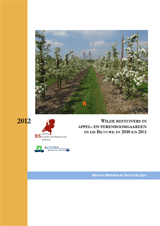 |
|
Reemer, M. & D. Klein, 2012
Wilde bestuivers in appel- en perenboomgaarden in de Betuwe in 2010 en 2011
EIS2012-01, EIS-Nederland & Alterra, 27 pp.
Naast de honingbij, die in Nederland niet of nauwelijks in het wild voorkomt, telt de Nederlandse biodiversiteit telt circa 350 soorten wilde bijen. Ook komen er circa 330 soorten zweefvliegen in Nederland voor. Vermoed wordt dat een deel van de wilde bijen en zweefvliegen "ecosysteemdiensten" uitvoert in de vorm van bestuiving van landbouwgewassen, maar tot nu toe was onbekend welke soorten dat zoal zijn. In opdracht van het Ministerie van EL&I voerden EIS-Nederland en Alterra in 2010 en 2011 een onderzoek uit naar wilde bestuivende insecten in appel- en perenboomgaarden in de Betuwe.
Achterliggende onderzoeksvragen waren:
1. Welke soorten wilde bijen en zweefvliegen worden waargenomen op bloemen van landbouwgewassen?
2. Op welke afstanden van hun (vermoedelijke) nestelplaatsen worden deze bijensoorten nog aangetroffen op landbouwgewassen?
3. Gebruiken deze soorten in dezelfde gebieden daarnaast andere stuifmeelbronnen?
Het huidige rapport doet verslag van een onderzoek om de eerste twee vragen te beantwoorden. De derde vraag komt in een afzonderlijk onderzoek aan de orde. De resultaten uit deze studie suggereren dat wilde bijen belangrijk kunnen zijn voor de bestuiving van appel- en perenbloesems. Mogelijk kunnen wilde bijen de rol van honingbijen in deze bestuiving zelfs grotendeels of geheel overnemen. In de onderzochte boomgaarden lijken zweefvliegen in dit opzicht van veel geringer belang. Kwantitatief onderzoek aan vruchtzetting is echter nodig om het relatieve belang van wilde bijen ten opzichte van honingbijen nader te bepalen. |
|
Downloaden |
|
|
|
|
|
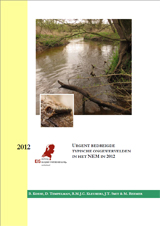 |
|
Koese, B., D. Tempelman, R.M.J.C. Kleukers, J.T. Smit & M. Reemer, 2012
Urgent bedreigde typische ongewervelden in het NEM in 2012
EIS2012-04, EIS-Nederland, 22 pp. + bijlagen
Elk EU-land heeft, conform de verplichtingen die voortvloeien uit de habitatrichtlijn, de verantwoordelijkheid om te zorgen voor een gunstige staat van instandhouding van de verschillende habitattypen en (bijbehorende) soorten. Eens in de zes jaar rapporteren de lidstaten de staat van instandhouding van de soorten en habitats aan de EU. De afgelopen rapportageperiode liep formeel van 2007-2012, maar is opgesteld aan de hand van de data die verzameld zijn tot en met 2011.
In de voorliggende rapportage worden de gegevens gepresenteerd die verzameld zijn in 2012, ten behoeve van de rapportage aan de EU over de periode 2013-2018. |
|
Downloaden |
|
|
|
|
|
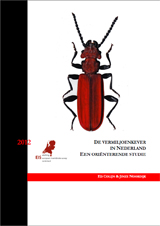 |
|
Colijn, E.O. & J. Noordijk, 2012
De vermiljoenkever in Nederland. Een oriënterende studie
EIS2012-02, EIS-Nederland, 27 pp.
In 2012 heeft EIS-Nederland in opdracht van het Ministerie van Economische Zaken een onderzoek verricht naar het voorkomen van de vermiljoenkever Cucujus cinnaberinus in Nederland. Aanleiding was de ontdekking van deze soort op 11 januari 2012. Doel van het onderzoek was vast te stellen of de soort ook op andere locaties voorkomt, in welk biotoop hij zich ophoudt, of de huidige populatie(s) afdoende beschermd worden en of de noodzaak bestaat aanvullend verspreidingsonderzoek uit te voeren.
Tijdens het onderzoek zijn in één gebied diverse imago's, larven en poppen gevonden. Daarbuiten zijn geen vondsten gedaan. Het voorkomen van de vermiljoenkever in Nederland lijkt zich vooralsnog te beperken tot één kwetsbare populatie maar het is niet geheel uit sluiten dat de kever zich inmiddels ook al in ander geschikte gebieden heeft gevestigd. |
|
Niet openbaar |
|
|
|
|
|
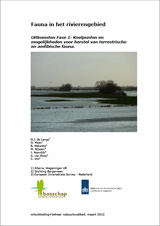 |
|
Lange, H.J. de, G. Maas, B. Makaske, M. Nijssen, J. Noordijk, S. van Rooij & C. Vos, 2012
Fauna in het rivierengebied. Uitkomsten Fase 1: Knelpunten en mogelijkheden voor herstel van terrestrische en amfibische fauna
Rapport nr. 2012/OBN160-RI, Directie Kennis en Innovatie, Ministerie van Economische Zaken, Landbouw en Innovatie
Deze studie richt zich op het maken van een analyse van de belangrijkste knelpunten voor karakteristieke terrestrische en amfibische fauna in het rivierengebied en de mogelijkheden te verkennen voor het opheffen van deze knelpunten binnen de huidige randvoorwaarden van het Nederlandse rivierengebied.
Deze kennis vormt de basis voor de beheersadviezen die OBN geeft voor optimalisatie van herstel en behoud van de biodiversiteit in het rivierengebied.
Dit rapport beschrijft de resultaten van fase 1, waarin het accent ligt op de ontwikkeling van een conceptueel raamwerk en het inventariseren van beschikbare faunadata voor verdere analyse. |
|
Niet openbaar |
|
|
|
|
|
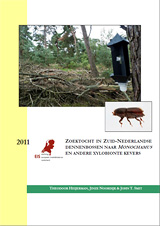 |
|
Heijerman, Th., J. Noordijk & J.T. Smit, 2011
Zoektocht in Zuid-Nederlandse dennenbossen naar Monochamus en andere xylobionte kevers
EIS2011-06, EIS-Nederland, 22 pp. + bijlagen
Boktorren van het genus Monochamus zijn vectoren voor het dennenhoutaaltje Bursaphelenchus xylophilus. Dit is een nematode die voornamelijk leeft in dennen en daar verantwoordelijk is voor de dennenverwelkingsziekte. De aanwezigheid van de nematode leidt tot het stagneren van het watertransport in de boom waardoor die kan sterven.
In opdracht van de Plantenziektenkundige Dienst (nu nieuwe Voedsel- en Warenautoriteit, nVWA) is in 2009 informatie over het geslacht Monochamus in Nederland bijeengebracht en is er een inventarisatie uitgevoerd in het duingebied tussen Schoorl en Bergen. In 2010 is een vervolgonderzoek uitgevoerd in de duinen van Noord-Holland en Zuid-Holland. Aangezien Monochamus-soorten ook in dennenbossen buiten het duingebied kunnen voorkomen, was het noodzakelijk om ook andere delen van Nederland te inventariseren. Dit rapport behandelt de inventarisatie van enkele dennenbossen in Noord-Brabant, Limburg en Wageningen op Monochamus-soorten en andere xylobionte soorten dat is uitgevoerd in 2011. |
|
Downloaden |
|
|
|
|
|
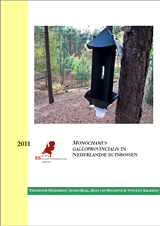 |
|
Heijerman, Th., G. Keijl, K. van Bochove & V. Kalkman, 2011
Monochamus galloprovincialis in de Nederlandse duinbossen
EIS2010-05, EIS-Nederland, 17 pp. + bijlagen
Het dennenhoutaaltje Bursaphelenchus xylophilus is een nematode die voornamelijk leeft in dennen. De nematode is verantwoordelijk voor een ziekte die in het Engels de 'pine wilt desease' heet, vertaald de dennenverwelkingsziekte. De aanwezigheid van de nematode leidt tot het stagneren van het watertransport in de boom waardoor de boom sterft. De nematode verspreidt zich niet op eigen kracht maar via transport van hout (bomen), verpakkingshout (pallets) en schors (houtsnippers). Daarnaast verplaats deze nematode zich van boom van boom door mee te liften met kevers. De belangrijkste vectoren lijken op dit moment boktorren van het genus Monochamus. In opdracht van de Plantenziektenkundige Dienst is in 2009 informatie over het geslacht Monochamus in Nederland bijeengebracht en is er een inventarisatie uitgevoerd in het duingebied tussen Schoorl en Bergen (Noord-Holland). In 2010 is een vervolgonderzoek uitgevoerd in de duinen van Noord-Holland en Zuid-Holland. Tijdens het huidige onderzoek werden twaalf exemplaren gevangen op dezelfde locaties als in 2009. Op basis van deze inventarisatie lijkt het ons niet erg waarschijnlijk dat de soort zich nog op een tweede locatie in het duingebied van Noord- of Zuid-Holland heeft weten te vestigen. |
|
Downloaden |
|
|
|
|
|
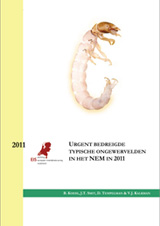 |
|
Koese, B., J.T. Smit, D. Tempelman & V.J. Kalkman, 2011
Urgent bedreigde typische ongewervelden in het NEM in 2011
EIS2011-04, EIS-Nederland, 17 pp. + bijlagen
In 2010 heeft de stuurgroep van het Netwerk Ecologische Monitoring (NEM) nieuwe meetdoelen vastgesteld voor de afzonderlijke dier- en plantgroepen. Het is de bedoeling dat, behalve van de soorten van de habitatrichtlijn, ook van de (potentiëel) urgent bedreigde typische soorten structureel een vinger aan de pols gehouden gaat worden. Voor habitatrichtlijnsoorten is verspreiding op 10*10 km-hokniveau, informatie over de landelijke trend en informatie over de trend per Natura2000-gebied gewenst. Voor de (potentieel) urgent bedreigde typische soorten, zoals geformuleerd in Epe et al. 2009, wordt beoogd om de verspreiding minimaal op 5*5 km-hok niveau compleet te hebben.
In deze rapportage worden de eerste resultaten van enkele groepen ongewervelden besproken, te weten het vliegend hert, de gestreepte waterroofkever, sprinkhanen en kokerjuffers. |
|
Downloaden |
|
|
|
|
|
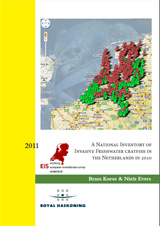 |
|
Koese, B. & N. Evers, 2011
A national inventory of invasive freshwater crayfish in the Netherlands in 2010
EIS2011-03, EIS-Nederland, 52 pp.
Ongeveer 200 vrijwilligers uit heel Nederland droegen in het najaar van 2010 bij aan een bijzonder inventarisatieproject: het verspreidingsonderzoek uitheemse rivierkreeften. Het doel van dit project was het in kaart brengen van de landelijke verspreiding van deze soortgroep. De gebruikte methode was weliswaar niet selectief voor uitheemse soorten rivierkreeften, maar omdat de enige inheemse kreeft (de Europese rivierkreeft Astacus astacus) in Nederland vrijwel is uitgestorven, werden in praktijk alleen uitheemse rivierkreeften gevangen (naast de bijvangsten). Daarnaast is geprobeerd om de habitatvoorkeur te bepalen van een reeds lang gevestigde exoot, de gevlekte Amerikaanse rivierkreeft Orconectes limosus. Tenslotte is van recentere nieuwkomers (in het bijzonder de rode Amerikaanse rivierkreeft Procambarus clarkii) onderzocht of de soorten effect kunnen hebben op de kwalititeit en structuur van het ecosysteem. |
|
Downloaden |
|
|
|
|
|
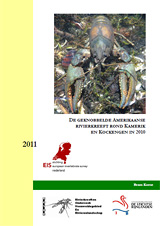 |
|
Koese, B., 2011
De geknobbelde Amerikaanse rivierkreeft rond Kamerik en Kockengen in 2010
EIS2011-01, EIS-Nederland, 15 pp.
In een aantal watergangen in het beheergebied van het Hoogheemraadschap De Stichtse Rijnlanden (HDSR) is de vegetatie de afgelopen tijd sterk teruggelopen. Watergangen die normaal gesproken de afvoer van water remmen door de aanwezigheid van (submerse) vegetatie, zijn dit jaar grotendeels open gebleven. Hierdoor is ongeveer 85% van het maaibestek in deelgebied OR04 (oostelijke groene hart regio) voor 2010 komen te vervallen. De opvallende decimering van de vegetatie is mogelijk het gevolg van de aanwezigheid van Amerikaanse rivierkreeften, de geknobbelde Amerikaanse rivierkreeft (Orconectes virilis) in het bijzonder. HDSR heeft Stichting EIS verzocht om een korte quick-scan uit te voeren om de aanwezigheid van kreeften in het gebied te verifiëren. Met behulp van fuiken zijn een aantal sloottrajecten in de regio rond Kamerik, Kockengen en Woerdense Verlaat bemonsterd in augustus en november 2010. In dit rapport wordt verslag gedaan van de inventarisatie, aangevuld met gegevens die door vrijwilligers van Stichting EIS-Nederland verzameld zijn. |
|
Downloaden |
|
|
|
|
|
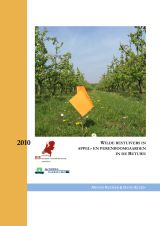 |
|
Reemer, M. & R. Klein, 2010
Wilde bestuivers in appel- en perenboomgaarden in de Betuwe
EIS2010-04, EIS-Nederland & Alterra, 23 pp.
In opdracht van het Ministerie van LNV voerden EIS-Nederland en Alterra in 2010 een onderzoek uit naar wilde bestuivende insecten in appel- en perenboomgaarden in de Betuwe tussen Zaltbommel en Echteld. Achterliggende onderzoeksvragen waren:
1. Welke bijen- en zweefvliegsoorten verzamelen stuifmeel op landbouwgewassen?
2. Op welke afstanden van hun (vermoedelijke) nestelplaatsen worden deze bijensoorten nog aangetroffen op landbouwgewassen?
3. Gebruiken deze soorten in dezelfde gebieden daarnaast andere pollenbronnen?
Dit voorlopige rapport doet verslag van een onderzoek om de eerste twee vragen te beantwoorden. De derde vraag komt in een latere fase aan de orde. In 2012 werd een completer verslag van dit onderzoek gepubliceerd (zie hier boven). |
|
Downloaden |
|
|
|
|
|
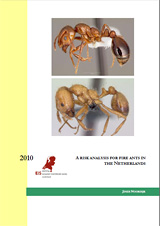 |
|
Noordijk, J., 2010
A risk analysis for fire ants in the Netherlands
EIS2010-03, EIS-Nederland
Geregeld worden brandmieren aangetroffen tijdens importinspecties. Solenopsis invicta, S. geminata en S. richteri zijn notoire invasieve exoten die in grote delen van de wereld voor veel overlast zorgen. Dit was voor het Team Invasieve Exoten (van het Ministerie van EL&I) de aanleiding om een risicoanalyse voor brandmieren in Nederland uit te laten voeren. Deze moet inzicht geven in het aantal importen in Nederland, of ze zich hier kunnen vestigen, welke gevolgen eventuele vestigingen zullen hebben voor mens en de natuur, en op welke wijze ze eventueel bestreden kunnen worden.
In Nederland is het onwaarschijnlijk dat brandmieren zich buiten kunnen vestigen. Een in de literatuur beschikbare klimaatanalyse laat zien dat S. invicta zich niet kan voortplanten in Nederland, omdat het klimaat te koud is. Solenopsis geminata is nog meer een warmteminnende soort dan S. invicta, dus voor deze soort is het Nederlandse klimaat helemaal ongeschikt. Vestigingen van een nest in permanent verwarmde gebouwen is wel mogelijk en de mieren kunnen daar overlast veroorzaken. Dergelijke vestigingen kunnen gemakkelijk en met succes worden bestreden. Import van mierennesten moet echter wel streng in de gaten gehouden worden. Mieren zijn soms moeilijk op naam te brengen en er zijn vele potentiële invasieve mierensoorten. Een risicoanalyse gaat doorgaans uit van de onveranderlijkheid van een soort. Het blijft echter mogelijk dat een kleine verandering in gedrag of genetisch materiaal ervoor kan zorgen dat een exoot toch succesvol kan aanslaan in een nieuw leefgebied waarvan werd aangenomen dat het niet geschikt zou zijn. |
|
Downloaden |
|
|
|
|
|
|
|
Koese, B., J.G.M. Cuppen, G. van Dijk & O. Vorst, 2010
Populatieschatting van de brede geelgerande waterroofkever Dytiscus latissimus in Nederland
EIS2010-02, EIS-Nederland. |
|
Niet openbaar |
|
|
|
|
|
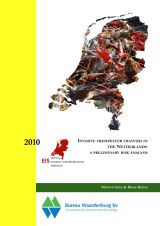 |
|
Soes, D.M. & B. Koese, 2010
Invasive freshwater crayfish in the Netherlands: a preliminary risk analysis
EIS2010-01, EIS-Nederland.
Tien soorten kreeften zijn waargenomen in Nederland: één inheemse soort en negen invasieve soorten. Zes soorten hebben zich gevestigd (Turkse rivierkreeft Astacus leptodactylus, Californische rivierkreeftPacifastacus leniusculus, gevlekte Amerikaanse rivierkreeft Orconectes limosus, geknobbelde Amerikaanse rivierkreeft Orconectes virilis, gestreepte Amerikaanse rivierkreeft Procambarus acutus en de rode Amerikaanse rivierkreeft Procambarus clarkii), de status van één soort (de marmerkreeft Procambarussp.) is onzeker en twee soorten (de steenkreeft Austropotamobius torrentium en de Australische roodklauwkreeft Cherax quadricarinatus) zijn slechts één maal waargenomen. Door de opmerkelijke opmars van een aantal soorten zijn er zorgen gerezen over de mogelijke gevolgen van de kreeften voor flora, fauna en infrastructuur. In deze studie is de waarschijnlijkheid van binnenkomst, vestiging en verspreiding van de verschillende soorten onderzocht. Daarbij is een inschatting gemaakt van de impact. |
|
Downloaden |
|
|
|
|
|
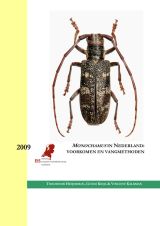 |
|
Heijerman, Th., G.O. Keijl & V.J. Kalkman, 2009
Monochamus in Nederland: voorkomen en vangmethoden
EIS2009-08, EIS-Nederland.
Bursaphelenchus xylophilus (Steiner & Bührer, 1934), het dennenhoutaaltje, is een vermoedelijk van oorsprong Noord-Amerikaanse nematode die voornamelijk leeft in dennen (Pinus spec.). De aanwezigheid van het aaltje leidt tot het stagneren van het watertransport in de boom waardoor de boom sterft. Eenmaal aangetaste bomen zijn niet meer te redden en het tegengaan van verspreiding is dan ook de belangrijkste maatregel. De nematode is niet in staat om zichzelf van boom naar boom te verplaatsen en komt op andere bomen terecht door mee te liften met kevers. Zo ver bekend zijn boktorren van het geslacht Monochamus de belangrijkste vectoren. Het voorkomen van de invoer en verdere verspreiding van Monochamus-soorten is één van de belangrijkste maatregelen voor het voorkomen van uitbraken van het dennenhoutaaltje. In opdracht van de Plantenziektenkundige Dienst is in 2009 informatie over het geslacht Monochamus in Nederland bijeengebracht en is er een inventarisatie uitgevoerd op de enige Nederlandse locatie waarvan een populatie van een Monochamus-soort bekend is. |
|
Downloaden |
|
|
|
|
|
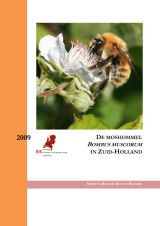 |
|
Roos, M. & M. Reemer, 2009
De moshommel Bombus muscorum in Zuid-Holland
EIS2009-05, EIS-Nederland.
In 2007 is het Leefgebiedenbeleid van het Ministerie van LNV van start gegaan. Met dit beleid streeft men naar de actieve bescherming van plant- en diersoorten binnen de samenhang van hun gemeenschappelijke leefgebied. Per Leefgebied bestaat een 'actielijst' van bedreigde soorten die goed herkenbaar zijn en een signaalfunctie hebben voor meer soorten in het Leefgebied. Op deze actielijsten staan enkele soorten waarover onvoldoende kennis beschikbaar is om direct tot uitvoer van maatregelen over te kunnen gaan. Eén van die soorten is de moshommel. De moshommel staat als bedreigd op de Nederlandse Rode Lijst. In het Leefgebiedenbeleid is de moshommel opgenomen als aandachtsoort voor de Leefgebieden Kustgebied en Agrarisch landschap. De soort is sterk achteruitgegaan in Nederland, zonder dat precies duidelijk is hoe dat komt. De Provincie Zuid-Holland maakte het mogelijk om in enkele Zuid-Hollandse populaties nader onderzoek te doen, om zo meer zicht te krijgen op de eisen die de soort aan zijn omgeving stelt. Dit rapport doet verslag van dit onderzoek. |
|
Downloaden |
|
|
|
|
|
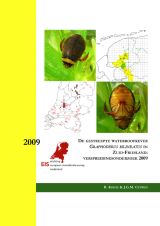 |
|
Koese, B. & J.G.M. Cuppen, 2009
De gestreepte waterroofkever Graphoderus bilineatus in Zuid-Friesland: verspreidingsonderzoek 2009
EIS2009-04, EIS-Nederland.
In het kader van het project “Inhaalslag Verspreidingsgegevens Ongewervelden” in opdracht van het ministerie van Landbouw, Natuurbeheer en Voedselkwaliteit (LNV) doet Stichting EIS sinds een aantal jaar onderzoek naar de verspreiding van de beschermde gestreepte waterroofkever Graphoderus bilineatus. Het doel van het verspreidingsonderzoek in 2009 is het completeren van de verspreidingskennis van de gestreepte waterroofkever in uurhokken (5x5 kmhokken) die niet eerder onderzocht waren, maar die wel gelegen zijn binnen het gebied dat door Cuppen et al. (2007) is aangeduid als 'mogelijk areaal'. In totaal zijn negen uurhokken in Zuid-Friesland onderzocht, waarbij per uurhok twee kmhokken geselecteerd zijn op basis van ‘expert judgement’, zodat in totaal 18 kmhokken bemonsterd zijn. De gestreepte waterroofkever werd in één kmhok aangetroffen, langs een woonwijk in het noorden van Joure. Op nationale schaal is de soort nu bekend uit 90 kmhokken, 34 uurhokken en 18 10x10 kmhokken. |
|
Downloaden |
|
|
|
|
|
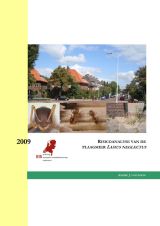 |
|
Loon, A.J. van, 2009
Risicoanalyse van de plaagmier Lasius neglectus
EIS2009-03, EIS-Nederland.
De plaagmier Lasius neglectus van Loon, Boomsma & Andrásfalvy, 1990 werd in de vroege jaren 1970 ontdekt en beschreven van Boedapest (Hongarije). De mier is inmiddels op een groot aantal plekken in Europa en Voor-Azië gevonden en gedraagt zich soms invasief. Uit Europa worden jaarlijks nieuwe vindplaatsen bekend, maar uit Nederland was de soort nog niet bekend. Lasius neglectus kan overlast bezorgen in de stedelijke omgeving en ook invloed hebben op de lokale biodiversiteit. Dit was aanleiding voor Team Invasieve Exoten om aan EIS-Nederland de opdracht te verstrekken een risicoanalyse op te stellen voor de plaagmier. Het onderzoek leverde een verrassend resultaat op: L. neglectus blijkt al decennialang aanwezig in ten minste vijf gemeenten in Nederland, met de eerste melding al in 1978. De determinaties worden ondersteund door DNA-analyses. |
|
Niet openbaar |
|
|
|
|
|
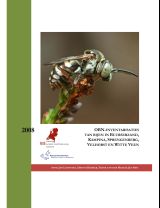 |
|
Loonstra, A.J., M. Reemer, F. van der Meer & J. Smit, 2008
OBN-inventarisaties van bijen in Buurserzand, Kampina, Sprengenberg, Velhorst en Witte Veen
EIS2008-10, EIS-Nederland.
Op initiatief van de Vereniging Natuurmonumenten heeft Stichting EIS-Nederland in 2008 de bijenfauna geïnventariseerd van vijf terreinen (zie onder). Speciale aandacht ging hierbij uit naar terreindelen waar in het kader van het Overlevingsplan Bos en Natuur (OBN) maatregelen getroffen zijn of zullen worden om verzuring, vermesting en verdroging tegen te gaan. Elk gebied is minimaal drie keer bezocht. Per gebied wordt de aangetroffen bijenfauna besproken en waar mogelijk vergeleken met gegevens uit eerdere jaren. Ook worden er aanbevelingen gegeven voor beheer ten gunste van de bijenfauna. |
|
Downloaden |
|
|
|
|
|
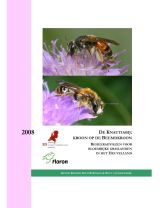 |
|
Reemer, R., R. Beringen & W. van der Slikke, 2008
De knautiabij: kroon op de beemdkroon. Beheeradviezen voor bloemrijke graslanden in het Heuvelland
EIS2008-09, EIS-Nederland.
Sinds 2007 maakt de knautiabij (Andrena hattorfiana) deel uit van de lijsten van aandachtsoorten die zijn opgesteld in het kader van het Leefgebiedenbeleid van het Ministerie van LNV. De knautiabij is aangewezen als aandachtsoort voor het Leefgebied Heuvelland. Door de sterke binding van deze bij met beemdkroon (Knautia arvensis) is het in het Heuvelland een kenmerkende soort voor bloemrijke graslanden. Deze graslanden staan in het Heuvelland sterk onder druk als gevolg van verruiging en ongunstig beheer. Met name schrale hooilanden en lijnvormige elementen als bermen, akker- en bosranden zijn in kwaliteit sterk achteruitgegaan. Deze gebieden worden vaak niet als natuurgebied beheerd en vallen door hun kleinschalige karakter buiten de Ecologische Hoofdstructuur. Dit rapport geeft beheeradviezen voor deze landschapselementen in het Leefgebied Heuvelland, met de knautiabij als vlaggenschip. |
|
Downloaden |
|
|
|
|
|
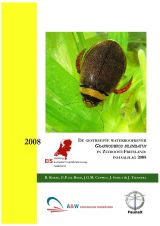 |
|
Koese, B., E.P. de Boer, J.G.M. Cuppen, J. Schut & J. Tienstra, 2008
De gestreepte waterroofkever Graphoderus bilineatus in Zuidoost-Friesland: inhaalslag 2008
EIS2008-11, EIS-Nederland.
In het kader van het project “Inhaalslag Verspreidingsgegevens Ongewervelden” in opdracht van het ministerie van Landbouw, Natuurbeheer en Voedselkwaliteit (LNV) doet Stichting-EIS sinds een aantal jaar onderzoek naar de verspreiding van de beschermde Gestreepte waterroofkever Graphoderus bilineatus. Om dit onderzoek efficiënt en doelgericht te kunnen uitvoeren is een model ontwikkeld dat de kans op voorkomen van de soort in een bepaald kilometerhok voorspelt op basis van indicatieve planten, gegevens over het electrisch geleidingsvermogen (EGV) en de aanwezigheid van laagveen. De eerste versie van dit model bleek de aanwezigheid van de soort redelijk goed te kunnen voorspellen in gebieden waaruit zowel flora- als EGV-gegevens bekend waren. Gebieden zonder vegetatiegegegevens waren tot dusver niet onderzocht. Het doel van deze inhaalslag was om de betrouwbaarheid te toetsen van de kansberekeningen zonder vegetatiegegevens volgens het tweede, aangepaste verspreidingsmodel uit 2007. |
|
Niet openbaar |
|
|
|
|
|
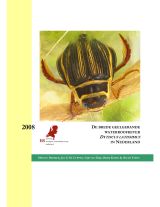 |
|
Reemer, M., J.G.M. Cuppen, G. van Dijk, B. Koese & O. Vorst, 2008
De brede geelgerande waterroofkever Dytiscus latissimus in Nederland
EIS2008-08, EIS-Nederland.
De brede geelgerande waterroofkever Dytiscus latissimus is internationaal beschermd via de Habitatrichtlijn. In Nederland was de soort sinds 1967 niet meer gevonden, totdat hij in 2005 werd herontdekt in Zuidwest-Drenthe. Een verkennend onderzoek in het betreffende gebied in 2006 leerde dat de soort er in minstens vier verschillende vennen voorkomt. In 2006 en 2007 heeft EIS-Nederland in opdracht van het Ministerie van LNV een landelijk vervolgonderzoek uitgevoerd naar de Nederlandse verspreiding van de brede geelgerande waterroofkever. Tijdens een verkenningsronde in het voorjaar van 2007 zijn in de wijde omgeving van de bekende vindplaatsen 36 vennen geselecteerd die op basis van hun morfologie en vegetatie mogelijk geschikt leken voor de soort. In aanvulling hierop zijn 13 vennen geselecteerd op historische vindplaatsen elders in Nederland. De totale selectie van 49 vennen is onderzocht in de nazomer van 2007 en het voorjaar van 2008.
In geen van de onderzochte vennen is de brede geelgerande waterroofkever aangetroffen. De Nederlandse populatie van de brede geelgerande waterroofkever lijkt geheel beperkt te zijn tot de omgeving van Uffelte en het Dwingelderveld in Zuidwest-Drenthe. In deze gebieden liggen nog vele vennen die niet onderzocht zijn, maar die mogelijk wel geschikt zijn als biotoop voor deze waterkever. Momenteel is niet duidelijk in welke vennen de soort nog meer voorkomt en hoe groot de populaties zijn. Ook is niet duidelijk wat de biotoopeisen van de soort zijn. Om monitoring aan de soort te kunnen uitvoeren en om de soort in Nederland effectief te kunnen beschermen, is beter onderzoek naar zijn voorkomen in Zuidwest-Drenthe noodzakelijk. Ook is het nodig om de soort op te nemen in de aanwijzingsbesluiten voor deze gebieden in het kader van Natura 2000. |
|
Niet openbaar |
|
|
|
|
|
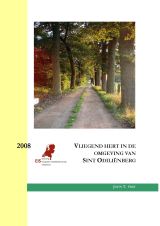 |
|
Smit, J.T., 2008
Vliegend hert in de omgeving van Sint Odiliënberg
EIS2008-05, EIS-Nederland.
In 2008 heeft EIS-Nederland in opdracht van de Gegevensautoriteit Natuur van het ministerie van Landbouw, Natuur en Voedselkwaliteit een onderzoek uitgevoerd naar het voorkomen van het vliegend hert in de omgeving van Sint Odiliënberg. Aanleiding voor dit onderzoek was een waarneming uit 2007 gecombineerd met het feit dat er uit deze omgeving reeds enkele waarnemingen bekend waren uit de periode 1801-1995. De focus van het onderzoek lag duidelijk op het potentiële leefgebied Sint Odiliënberg, maar uitgangspunt bij dit onderzoek was een aanzet voor een complete actualisatie van de verspreiding op het niveau van 10x10 kilometer in de periode 2007-2012 en tevens het actualiseren van het verspreidingsbeeld op 1x1 kilometerhokniveau als voorbereiding op de te ontwikkelen kansenkaarten.
Uit de omgeving van Sint Odiliënberg zijn twee betrouwbare waarnemingen binnengekomen, een mannetje op het terrein van de Clauscentrale in Maasbracht en een mannetje van de Meinweg, nabij het Maharishi Mahesh klooster. Op basis van deze beide vondsten, samen met die uit 2007 en de beoordeling van de verschillende stukken bos in deze omgeving moet aangenomen worden dat deze omgeving een actueel leefgebied vormt voor het vliegend hert. Hiermee wordt het aantal verspreidingsgebieden uitgebreid naar 5. Er dient echter wel opgemerkt te worden dat het vliegend hert in de omgeving van Sint Odiliënberg vermoedelijk erg zeldzaam is en slechts enkele verspreide en geïsoleerde populaties heeft, vergelijkbaar met het voormalige(?) verspreidingsgebied de Utrechtse Heuvelrug.
|
|
Downloaden |
|
|
|
|
|
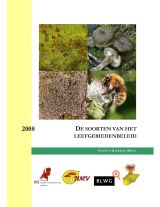 |
|
Kalkman, V.J., 2008
De soorten van het leefgebiedenbeleid
EIS2008-04, EIS-Nederland.
In 2007 is het nieuwe soortenbeleid van start gegaan. Dit zogenoemde leefgebiedenbeleid richt zich meer dan voorheen op groepen van soorten die een gezamenlijk biotoop delen. Daarnaast wordt meer integratie in andere beleidsterreinen, plannen en maatregelen gezocht en wordt gepoogd meer partners, zoals provincies, terreinbeherende organisaties, waterschappen en het bedrijfsleven, te betrekken.
Bij het nieuwe beleid hoort ook een nieuwe lijst met soorten waarop het beleid is gericht. Deze lijst is door LNV vastgesteld en bestaat vooral uit soorten van de Habitatrichtlijn en soorten die op de Nederlandse Rode lijsten staan. Uit deze laatste categorie zijn voornamelijk soorten gekozen die als bedreigd of sterk bedreigd op de Rode lijst staan. Niet alle soorten uit deze categorieen konden worden opgenomen. Van enkele grote groepen zoals bijen en paddestoelen is een selectie gemaakt waarbij vooral soorten zijn gekozen die goed herkenbaar zijn en een signaalfunctie hebben voor meerdere soorten van de groep.
Een deel van de dier- en plantengroepen die in het leefgebiedenbeleid zijn opgenomen speelden tot nu geen belangrijke rol in het Nederlandse natuurbeleid. Deze groepen zijn vaak relatief onbekend en kennis over verspreiding en beheer is vaak moeilijk te vinden. Het voorliggende rapport is opgesteld met als doel de kennis over deze soorten te ontsluiten en voor iedereen beschikbaar te maken. |
|
Downloaden |
|
|
|
|
|
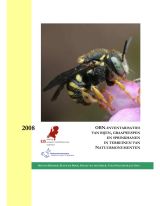 |
|
Reemer, M., P. de Boer, F. van der Meer, T. Peeters & J. Smit, 2008
OBN-inventarisaties van bijen, graafwespen en sprinkhanen in terreinen van Natuurmonumenten
EIS2008-01, EIS-Nederland.
Op initiatief van de Vereniging Natuurmonumenten heeft Stichting EIS-Nederland in 2007 inventarisaties uitgevoerd van bijen, graafwespen en sprinkhanen in 12 gebieden. Speciale aandacht gaat hierbij uit naar de 'OBN-plangebieden': terreindelen waar in het kader van het Overlevingsplan Bos en Natuur maatregelen getroffen worden om verzuring, vermesting en verdroging tegen te gaan. Per gebied wordt de aangetroffen fauna besproken en waar mogelijk vergeleken met beschikbare gegevens uit eerdere jaren. Er wordt geprobeerd een inschatting te maken van de (te verwachten) effecten van de geplande OBN-maatregelen op de onderzochte insectenfauna. |
|
Downloaden |
|
|
|
|
|
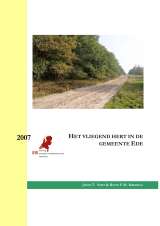 |
|
Smit, J.T. & R.F.M. Krekels, 2007
Het vliegend hert in de gemeente Ede
EIS2007-09, EIS-Nederland.
Het vliegend hert is een beschermde keversoort met een lange ontwikkelingsduur tot volwassen insect, minimaal 4 tot zo’n 8 jaar, en een beperkte verspreidingscapaciteit. Deze beide facetten maken haar tot een kwetsbare soort. Daar komt bij dat de weinige vindplaatsen veelal geïsoleerd liggen waardoor de soort extra kwetsbaar is. Het oorspronkelijke verspreidingsgebied van het vliegend hert in Nederland is de afgelopen decennia teruggedrongen tot vier kerngebieden. Twee daarvan liggen in ieder geval deels in de provincie Gelderland, waarmee deze provincie een centrale rol in het behoud van deze soort in Nederland inneemt. De verspreiding binnen de Gelderse kerngebieden laat zien dat de huidige populaties verspreid en tamelijk geïsoleerd liggen. Het doel van het voorliggende rapport is het duurzaam behouden van de populaties in het huidige leefgebied en het zoveel mogelijk onderling verbinden van de afzonderlijke populaties. |
|
Downloaden |
|
|
|
|
|
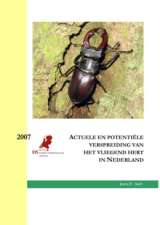 |
|
Smit, J.T., 2007
Actuele en potentiele verspreiding van het vliegend hert in Nederland
EIS2007-08, EIS-Nederland.
In 2007 heeft EIS-Nederland in opdracht van het Expertise centrum van het ministerie van Landbouw, Natuur en Voedselkwaliteit een onderzoek uitgevoerd naar de verspreiding van het vliegend hert. De focus bij deze inventarisatie lag op het in beeld brengen van de verspreiding op een schaal van 10x10 kilometer. Deze gegevens zijn van belang voor het bepalen van de range van de soorten van de Habitatrichtlijn ten behoeve van toekomstige rapportages van LNV over de staat van instandhouding aan de EU. De focus van het onderzoek in 2007 lag nadrukkelijk op drie gebieden waar ooit waarnemingen zijn gedaan (betrouwbaar of onduidelijk) en waarvan onduidelijk is of er zich populaties van het vliegend hert bevinden: Holterberg, Utrechtse Heuvelrug en Vriezeveen.
Uit de drie focus gebieden zijn geen aanvullende waarnemingen binnengekomen, ook kon middels veldwerk de aanwezigheid niet vastgesteld worden. Drie van de betrouwbare waarnemingen vallen op door de afgelegen vindplaatsen: Hilversum, Mijdrecht en Sint Odiliënberg. Van de eerste twee waarnemingen wordt aangenomen dat het gaat om versleepte exemplaren. Bij Sint Odiliënberg zijn er echter aanwijzingen dat er mogelijk een populatie aanwezig is in de omgeving, hetzij in Nederland, dan wel in het aangrenzende bos in Duitsland. Naar aanleiding van de enorme hoeveelheid waarnemingen van dit jaar verandert het actuele verspreidingsgebied niet. Als potentieel verspreidingsgebied worden de Holterberg, de Utrechtse Heuvelrug en, op basis van de waarneming van 2007 gecombineerd met de reeds bestaande informatie uit die omgeving, Sint Odiliënberg beschouwd. Vriezeveen wordt mede gezien de biotoop en het uitblijven van nieuwe waarnemingen niet als potentieel leefgebied van het vliegend hert beschouwd. |
|
Downloaden |
|
|
|
|
|
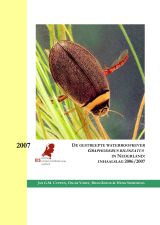 |
|
Cuppen, J.G.M., O. Vorst, B. Koese & H. Sierdsema, 2007
De gestreepte waterroofkever Graphoderus bilineatus in Nederland: inhaalslag 2006/2007
EIS2007-06, EIS-Nederland.
In 2004 en 2005 zijn alle vindplaatsen van de gestreepte waterroofkever Graphoderus bilineatus uit de periode 1980-2000 onderzocht. Op basis van die resultaten is toen een voorspelling gedaan over het potentiële verspreidingsgebied van deze beschermde keversoort in Nederland. Hieruit bleek dat er 141 kilometerhokken waren waarin de kans op vóórkomen van G. bilineatus op minimaal 70% werd geschat. Het huidige rapport doet verslag van een inventarisatie van dat potentiële verspreidingsgebied, die in 2006 en 2007 werd uitgevoerd door Stichting EIS-Nederland. |
|
Downloaden |
|
|
|
|
|
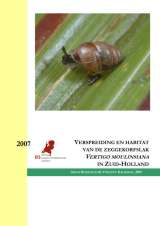 |
|
Boesveld, A. & V. Kalkman, 2007
Verspreiding en habitat van de zeggekorfslak Vertigo moulinsiana in Zuid-Holland
EIS2007-04, EIS-Nederland.
In 2005 werd onverwachts de zeggekorfslak op twee plaatsen in Zuid-Holland aangetroffen. De zeggekorfslak staat op de Habitatrichtlijn en geniet wettelijke bescherming. Om hieraan invulling te kunnen geven is het voor de provincie Zuid-Holland van belang om goede informatie over de verspreiding, biotoopkeuze en beheer van deze soort te hebben. In 2006 heeft de provincie daarom aan EIS-Nederland de opdracht gegeven om het voorkomen van de soort in de provincie in kaart te brengen.
Tijdens het in 2006 uitgevoerde veldwerk is V. moulinsiana in totaal in negen (deel)gebieden aangetroffen: Nieuwkoopse plassen, Kagerplassen, Braassemermeer en Wijde Aa, Rotte, Hennipsloot en Lange Vaart, Vlietlanden, Kinderdijk, Groote- of Achterwaterschap en De Alblas. Met uitzondering van de Nieuwkoopse plassen waar slechts één populatie werd gevonden, werden in al deze gebieden meerdere of zelfs vele populaties aangetroffen. Vooral in de Hooge Boezem van de Overwaard bij Kinderdijk is de soort erg talrijk. Naar schatting kwamen langs een traject van circa 100 meter tienduizenden zeggekorfslakken voor. De dichtheden lopen hier op tot circa 500 exemplaren per vierkante meter. Ook bij het Norremeer in het Kagerplassengebied werden plaatselijk zulke dichtheden geschat. Bij Kinderdijk strekt het leefgebied van V. moulinsiana zich uit langs een groot deel van de boezem de Groote of Achterwaterschap. Vanaf Kinderdijk tot aan het plaatsje Donk, een afstand van ca 11 km komt de soort voor. |
|
Downloaden |
|
|
|
|
|
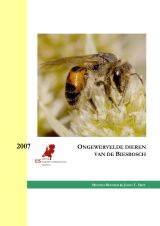 |
|
Reemer, M. & J.T. Smit, 2007
Ongewervelde dieren van de Biesbosch
EIS2007-03, EIS-Nederland.
In de loop der jaren hebben natuurliefhebbers vele gegevens verzameld over de ongewervelde dieren van de Biesbosch. Deze gegevens zijn opgeslagen in de databanken van Stichting EIS-Nederland en gelieerde organisaties. Dit rapport geeft een overzicht van de gegevens die van de volgende ongewervelde diergroepen beschikbaar zijn: bijen, loopkevers, mollusken, mieren, sprinkhanen, vlinders, wespen en zweefvliegen. Per diergroep wordt aangegeven voor welke soorten de Biesbosch van groot belang is voor de Nederlandse verspreiding. Aan de hand hiervan wordt bepaald welke groepen en soorten aandacht zouden moeten krijgen bij toekomstige inventarsaties, monitoring en beheersmaatregelen. Niet elke groep blijkt even goed geïnventariseerd in de Biesbosch. Ook bevatten niet alle groepen soorten waarvoor de Biesbosch van groot belang is. Onder de bijen, mollusken en vlinders komen diverse soorten in het gebied voor die voor een groot deel van hun Nederlandse verspreiding op de Biesbosch aangewezen zijn. Deze groepen verdienen daarom zeker extra aandacht. Overige groepen die mogelijk interessante soorten herbergen, maar nog onvoldoende bekend zijn, zijn loopkevers, wespen en zweefvliegen. Onder de mieren en sprinkhanen bevinden zich geen bijzonderheden.
|
|
Downloaden |
|
|
|
|
|
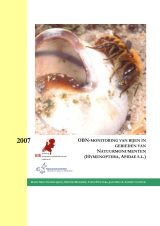 |
|
Nieuwenhuijsen, H., M. Reemer, Th. Peeters, J. Smit & A. van Eck, 2007
OBN-monitoring van bijen in gebieden van Natuurmonumenten (Hymenoptera, Apidae s.l.)
EIS2007-02,
Het Overlevingsplan Bos en Natuur (OBN) is ontwikkeld door het Ministerie van Landbouw, Natuur en Voedselkwaliteit om de effecten van verzuring, vermesting en verdroging in de Nederlandse natuur te verminderen. Op initiatief van Natuurmonumenten zijn in 2006 voor het eerst enkele inventarisaties van bijen uitgevoerd in het kader van het OBN. Dit gebeurde in vijf gebieden: Leggelderveld, Loonse en Drunense Duinen, Oldenaller: Heihoef, Steenbergerveld en Nationaal Park Zuid-Kennemerland. Per terrein wordt de aangetroffen bijenfauna besproken en waar mogelijk vergeleken met gegevens uit eerdere jaren. Kort wordt ingegaan op de relatie tussen de bijenfauna en het beheer van het terrein, met name de geplande OBN-ingrepen. |
|
Downloaden |
|
|
|
|
|
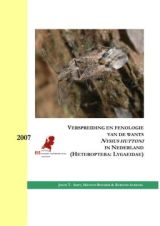 |
|
Smit, J.T., M. Reemer & B. Aukema, 2007
Verspreiding en fenologie van de wants Nysius huttoni in Nederland (Heteroptera: Lygaeidae)
EIS2007-01,
In opdracht van de Plantenziektenkundige Dienst heeft EIS-Nederland van 14 april tot en met 26 oktober 2006 een onderzoek uitgevoerd naar de verspreiding en populatiekarakteristieken van de wants Nysius huttoni White. Deze soort komt oorspronkelijk voor in Nieuw-Zeeland en is in 2002 voor het eerst in Nederland en België waargenomen. Vermoedelijk is hij via de haven van Antwerpen in Europa terechtgekomen. In Nieuw-Zeeland staat de soort bekend als een schadeverwekker bij tarwe en koolzaad. De Engelse naam is ‘the New Zealand wheat bug’, oftewel de Nieuw-Zeelandse tarwewants. De wantsen voeden zich met de sappen uit de tarwezaden, waarbij een enzym wordt afgescheiden dat in de plant aanwezig blijft. Bij verwerking van de tarwe tot deeg breekt het enzym de gluten af, waardoor het deeg slap en plakkerig wordt en het brood slecht van kwaliteit.
Het in Nederland, en deels in België, uitgevoerde onderzoek had tot doel het verspreidingsgebied in kaart te brengen, evenals het beschrijven van de populatiekarakteristieken en eventuele schade aan landbouwgewassen. Het onderzoek bestond uit een inventarisatie en een monitoring van enkele grote populaties. |
|
Downloaden |
|
|
|
|
|
|
|
Kalkman, V. & R. Kleukers, 2006
Quickscan boekenserie Nederlandse Fauna
EIS2006-07. |
|
|
|
|
|
|
|
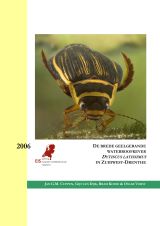 |
|
Cuppen, J.G.M. , G. van Dijk, B. Koese & O. Vorst, 2006
De brede geelgerande waterroofkever Dytiscus latissimus in Zuidwest-Drenthe
EIS2006-06, EIS-Nederland.
De verspreiding en de biotoop van de brede geelgerande waterroofkever Dytiscus latissimus in wateren, voornamelijk vennen, in Zuidwest-Drenthe is in 2006 onderzocht. Aanleiding voor dit onderzoek was de vondst van twee mannetjes van deze soort in het najaar van 2005 in een ven in de omgeving van Uffelte. Gedurende het onderzoek in 2006 in de maand september werden in 19 vennen en één middenloop van een laaglandbeek gedurende vier aaneensluitende nachten series met vallen opgesteld in ondiep water (30-60 cm). Op elke locatie werd verder een vegetatieopname gemaakt en een watermonster genomen.
Dytiscus latissimus is aangetroffen in vier vennen. Op basis van dit onderzoek kan niet met 100% zekerheid gesteld worden dat D. latissimus in de overige onderzochte vennen afwezig is. Een groter aantal series vallen per ven dan wel een langere bemonsteringsperiode is hiervoor noodzakelijk. Ook voor het schatten of berekenen van een betrouwbare populatiegrootte van D. latissimus in vennen waar de soort is aangetoond, is een ruimere inzet van middelen noodzakelijk. Het rapport besluit met enkele overwegingen en aanbevelingen met betrekking tot toekomstig onderzoek naar Dytiscus latissimus in Nederland. |
|
Niet openbaar |
|
|
|
|
|
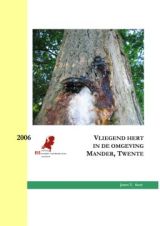 |
|
Smit, J.T., 2006
Vliegend hert in de omgeving Mander, Twente
EIS2006-05, EIS-Nederland.
In 2006 heeft EIS-Nederland in opdracht van het Expertise centrum van het ministerie van Landbouw, Natuur en Voedselkwaliteit een onderzoek uitgevoerd naar de verspreiding van het vliegend hert in de omgeving Mander, Twente. Dit betrof een inhaalslag verspreidingsonderzoek in het kader van het Amendement van der Ham. Veel media aandacht in de vorm van gepubliceerde oproepjes, verspreide posters en twee radiointerviews hebben er voor gezorgd dat er dit jaar 44 betrouwbare waarnemingen zijn binnengekomen uit de omgeving Mander. Dit is ruim 22% van het totaal aantal waarnemingen uit 2006. Dit is een erg groot aandeel voor een gebied van die geringe grootte.
Naast deze betrouwbare waarnemingen en voortplantingspopulaties zijn er ook enkele oncontroleerbare waarnemingen binnengekomen die aandacht verdienen. Twee omdat ze gedaan zijn in Nijverdal, aan de rand van de Holterberg waar respectievelijk in 1988 en 2002 een betrouwbare waarneming is gedaan van het vliegend hert. En in Vriezeveen zijn drie afzonderlijke waarnemingen binnengekomen, waarvan geen duidelijk bewijs geleverd kon worden, maar waar gezien de concentratie mogelijk toch sprake is van een populatie.
|
|
Downloaden |
|
|
|
|
|
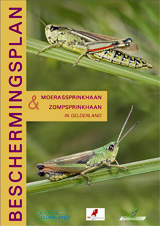 |
|
Reemer, M. & R. Krekels, 2006
Beschermingsplan moerassprinkhaan & zompsprinkhaan in Gelderland
EIS2006-04, EIS-Nederland & Natuurbalans Limes-Divergens, Leiden & Nijmegen,
De Provincie Gelderland is zeer belangrijk voor de Nederlandse sprinkhanenfauna: van de 18 soorten van de Rode Lijst zijn er 15 uit deze provincie bekend. De Provincie Gelderland is zich bewust van de verantwoordelijkheid die zij heeft voor haar sprinkhanenfauna. Dit blijkt uit het eerder verschenen beschermingsplan voor de zadelsprinkhaan en de kleine wrattenbijter, dat eveneens in opdracht van de Provincie is opgesteld. Voor het opstellen van het Beschermingsplan moerassprinkhaan & zompsprinkhaan zijn allereerst alle recente vindplaatsen van de moeras- en zompsprinkhaan bezocht om de huidige status vast te stellen. Vervolgens zijn de knelpunten en mogelijkheden in het beheer verkend. Er is contact gezocht met de beheerders van de betreffende natuurterreinen, om zo tot maatregelen te komen die ook bij de betrokkenen op draagvlak kunnen rekenen.
Op acht van de 12 locaties waar de moerassprinkhaan sinds 1980 is gevonden, kon de soort in 2005 niet worden teruggevonden. Uiteindelijk resteren vier plekken in Gelderland waarvan met zekerheid nog populaties bekend zijn. De zompsprinkhaan was buiten de concentratie van populaties in de oostelijke Achterhoek sinds 1980 op vijf locaties in Gelderland gevonden. Van deze vijf vindplaatsen bleken er drie betrekking te hebben op nog bestaande populaties. Bovendien is er nog een voorheen onbekende populatie ontdekt. Daarmee komt het aantal populaties buiten de oostelijke Achterhoek op vier. De populaties van beide soorten liggen geïsoleerd, dus de beheerders van de betreffende terreinen worden aangemoedigd om in hun beheer rekening te houden met deze kwetsbare soort. In dit beschermingsplan zijn dan ook algemene aanbevelingen per soort gegeven en tevens is het beheer specifiek per deelgebied vermeld.
|
|
Downloaden |
|
|
|
|
|
|
|
Boesveld, A. & V. Kalkman, 2006
Inventarisatie van de Westenschouwense Inlaag op het voorkomen van de Nauwe korfslak Vertigo angustior
EIS2006-03. |
|
Niet openbaar |
|
|
|
|
|
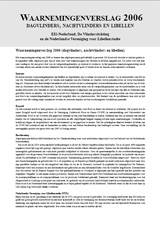 |
|
EIS-Nederland, De Vlinderstichting & Nederlandse Vereniging voor Libellenstudie, 2006.
Waarnemingenverslag 2006 (dagvlinders, nachtvlinders en libellen)
EIS2006-02
Het waarnemingenverslag van 2006 is dunner dan afgelopen jaren gebruikelijk is geweest. Dit komt niet doordat er minder gezien is. In tegendeel zelfs, afgelopen jaar zijn er weer zeer veel waarnemingen van vlinders en libellen aangeleverd. De reden voor het dunnere verslag is dat een groot deel van de verspreidingskaartjes op internet te vinden is. In het papieren waarnemingenverslag wordt voortaan alleen een aantal soorten behandeld die het opmerkelijk goed of slecht doen en daarom extra aandacht verdienen. |
|
Niet openbaar |
|
|
|
|
|
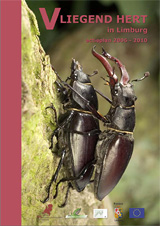 |
|
Smit, J.T. & R. Krekels, 2006
Vliegend hert in Limburg, actieplan 2006-2010
EIS2006-01, EIS-Nederland & Natuurbalans Limes-Divergens, Leiden & Nijmegen
Het vliegend hert is een beschermde keversoort met een lange ontwikkelingsduur tot volwassen insect, minimaal 4 tot zo’n 8 jaar, en een beperkte verspreidingcapaciteit. Deze beide facetten maken haar tot een kwetsbare soort. Daar komt bij dat de weinige vindplaatsen veelal geïsoleerd voorkomen in Limburg waardoor de soort extra kwetsbaar is. Het oorspronkelijke verspreidingsgebied van het vliegend hert in Nederland is de afgelopen decennia teruggedrongen tot vier kerngebieden. Twee hiervan liggen in Limburg, waarmee deze provincie een centrale rol voor het behoud van deze soort in Nederland inneemt. De verspreiding binnen de Limburgse kerngebieden laat zien dat de huidige populaties verspreid en tamelijk geïsoleerd liggen.
Het doel van het voorliggende actieplan is het duurzaam behouden van de huidige populaties en het zoveel mogelijk onderling verbinden van de afzonderlijke populaties. Veel populaties in Zuid-Limburg zijn te vinden in holle wegen, daarnaast bevinden ze zich ook in bosranden, houtwallen en zelfs tuinen. De populaties van een twaalftal deelgebieden, verdeeld over 3 prioriteitscategorieën, worden beschreven waarbij de bedreigingen en de gewenste maatregelen worden geformuleerd. Met dit actieplan wordt de basis gelegd voor de bescherming en het behoud van het vliegend hert in de provincie Limburg. Het is aannemelijk dat daarmee het vliegend hert in de provincie Limburg wordt veiliggesteld. Het juiste beheer van holle wegen en natuurgebieden zal dankzij de verschillende beherende instanties vorm moeten krijgen. Gezien de verspreiding van het vliegend hert zal de uitvoering over de grenzen van de formeel aangewezen natuurgebieden heen moeten reiken.Voorlichting aan beheerders én particulieren zal de uitvoering van de in het actieplan voorgestelde maatregelen zeer ten goede komen.
|
|
Downloaden |
|
|
|
|
|
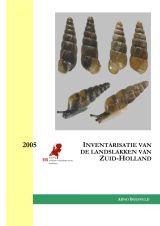 |
|
Boesveld, A., 2005
Inventarisatie van de landslakken van Zuid-Holland
EIS2005-13, EIS-Nederland.
In Nederland komen ruim 400 soorten weekdieren voor, waarvan er ruim 100 tot de landslakken behoren. Landslakken is een praktische verzamelnaam voor alle slakken met een voornamelijk terrestrische levenswijze. In Nederland komen twee landslakken voor die op de Habitatrichtlijn genoemd staan. Hoewel deze een strenge wettelijke bescherming genieten is de kennis over de verspreiding van deze soorten beperkt. Dit levert bij de uitvoering van het natuurbeleid vaak problemen op. Om hierin verandering te brengen is de landslakkenfauna van de provincie Zuid-Holland in 2004 en 2005 in kaart gebracht. Hierdoor is het voortaan mogelijk om bij het vaststellen en uitvoeren van het beleid rekening te houden met de twee soorten van de Habitatrichtlijn die in Zuid-Holland voorkomen (Vertigo angustior enV. moulinsiana). Naast aandacht voor de soorten van de Habitatrichtlijn is ook veel aandacht uitgegaan naar de soorten van de Rode-Lijst. |
|
Downloaden |
|
|
|
|
|
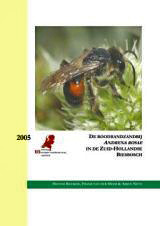 |
|
Reemer, M., F. van der Meer & A. Neve, 2005
De roodrandzandbij Andrena rosae in de Zuid-Hollandse Biebosch
EIS2005-12, EIS-Nederland.
De roodrandzandbij Andrena rosae is gedurende de 20e eeuw sterk achteruitgegaan in Nederland. Hierdoor staat de soort op de Rode Lijst van bedreigde bijen in de categorie 'ernstig bedreigd'. De enige resterende bekende populatie bevindt zich in de Biesbosch. In 2005 is de roodrandzandbij in het Zuid-Hollandse deel van de Biesbosch in kaart gebracht, om te onderzoeken of er mogelijkheden zijn om deze laatste populatie veilig te stellen. Het onderzoek werd uitgevoerd door EIS-Nederland in opdracht van de Provincie Zuid-Holland. Zowel in het voorjaar als in de zomer zijn enkele veldbezoeken aan de Zuid-Hollandse Biesbosch uitgevoerd.
Gezien de eisen die de roodrandzandbij - voor zover nu bekend - aan zijn omgeving stelt, is het moeilijk te begrijpen waarom deze bij landelijk zo sterk achteruit is gegaan, terwijl hij in de Zuid-Hollandse Biesbosch zo talrijk aanwezig is. De dijken waar de soort in nestelt zijn op veel meer plaatsen in Nederland aanwezig en hetzelfde geldt voor de wilgen en schermbloemen waar de vrouwtjes stuifmeel verzamelen. Ondanks deze onduidelijkheid is het de moeite waard om te proberen deze ernstig bedreigde soort te beschermen. Maatregelen die hierbij van nut kunnen zijn worden in dit rapport aangegeven. |
|
Downloaden |
|
|
|
|
|
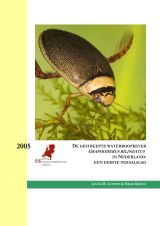 |
|
Cuppen, J.G.M. & B. Koese, 2005
De gestreepte waterroofkever Graphoderus bilineatus in Nederland: een eerste inhaalslag
EIS2005-11, EIS-Nederland.
De huidige verspreiding en de biotoop van de gestreepte waterroofkever Graphoderus bilineatus in Nederland zijn in 2004 en 2005 onderzocht. Uitgangspunt vormden de waarnemingen van deze soort in het bestand van EIS-Nederland sinds 1980 in 16 5x5-kilometerhokken, waarvan met voldoende zekerheid kon worden aangenomen dat deze betrouwbaar waren. In 12 van deze 16 hokken werd G. bilineatus teruggevonden. In slechts in één hok, waar G. bilineatus waarschijnlijk nog wel voorkomt, de soort niet teruggevonden. Daarnaast is G. bilineatus in drie 'nieuwe' hokken aangetroffen en is een voorheen als onbetrouwbaar in het EIS-bestand opgenomen waarneming alsnog betrouwbaar bevonden door controle van het betreffende dier door een expert.
Tevens werd op basis van gegevens over het electrisch geleidingsvermogen (EGV) van het water en de aquatische vegetatie een voorspellend model gemaakt voor de verspreiding van de gestreepte waterroofkever in Nederland. Met de uitkomsten van dit model is een kaart vervaardigd, waarop per kilometerhok is af te lezen hoe groot de kans is dat de soort er voorkomt. Dit levert 141 kilometerhokken op met een kans van 70% of meer op het voorkomen van de gestreepte waterroofkever. Deze selectie van hokken levert een kaartbeeld op dat aansluit bij de verwachting van het landelijke voorkomen op basis van 'expert judgement'. Daarom is deze selectie gebruikt in het uiteindelijke voorstel voor een landelijke inventarisatie van de gestreepte waterroofkever. Aan dit onderzoeksvoorstel zijn nog enkele kansrijke vennen op zandgrond toegevoegd. |
|
Downloaden |
|
|
|
|
|
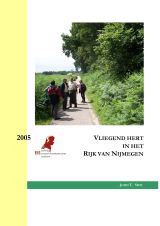 |
|
Smit, J.T., 2005
Vliegend hert in het Rijk van Nijmegen
EIS2005-10, EIS-Nederland.
In 2005 heeft EIS-Nederland in opdracht van het Expertise centrum van het ministerie van Landbouw, Natuur en Voedselkwaliteit een onderzoek uitgevoerd naar de verspreiding van het vliegend hert in het Rijk van Nijmegen. Dit betrof een inhaalslag verspreidingsonderzoek in het kader van het Amendement van der Ham. Een regionaal mediaoffensief, onder andere in de kringen van natuurliefhebbers, heeft er voor gezorgd dat er 23 betrouwbare waarnemingen van vliegende herten zijn binnengekomen uit het Rijk van Nijmegen. Dit is bijna 10% van het totaal aantal Nederlandse waarnemingen uit 2005. Dit is een groot aandeel gezien het geringe oppervlakte ten opzichte van de overige verspreidingsgebieden in Nederland. Naast de waarnemingen van volwassen kevers zijn er ook op twee zekere voortplantingsplekken aangetroffen. Deze informatie geeft een goed inzicht in de verspreiding van het vliegend hert in het Rijk van Nijmegen en het aangrenzende Duitse Reichswald.
Tijdens de voorlichtingsdag georganiseerd op 5 juli in Groesbeek heeft Klaus Kretschmer van het Biologisch station im Kreis Wesel e.V. een lezing gehouden over het voorkomen van het vliegend hert in Nordrhein-Westfalen, waarbij ook de ervaringen met het beheer aan bod kwamen. Tevens was een vertegenwoordiger van het NABU Naturschutzstation e.V. uit Kranenburg aanwezig. Met deze contacten is de kiem gelegd voor een internationale samenwerking tot het behoud van het vliegend hert in het Rijk van Nijmegen en aangrenzend Duitsland.
|
|
Downloaden |
|
|
|
|
|
|
|
Kalkman, V.J. & A. Boesveld, 2005
Inventarisatie van de Nauwe korfslak Vertigo angustior op de Brouwersdam en in het duingebied tussen Hoek van Holland en Ter Heijde
EIS2005-09. |
|
Niet openbaar |
|
|
|
|
|
|
|
Bouwman, J. & V.J. Kalkman, 2005
Eindrapportage inhaalslag libellen
De Vlinderstichting & EIS-Nederland, EIS2005-08. |
|
Niet openbaar |
|
|
|
|
|
|
|
Kalkman, V.J., 2005b
Inventarisatie van de Nauwe korfslak Vertigo angustior op 10 ha duingebied te Voorne
EIS2005-07.
|
|
Niet openbaar |
|
|
|
|
|
|
|
Kalkman, V.J., 2005a
Inventarisatie van de Nauwe korfslak Vertigo angustior op het Flaauwe werk, Goeree
EIS2005-06. |
|
Niet openbaar |
|
|
|
|
|
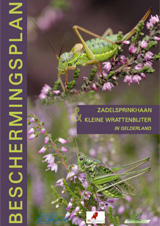 |
|
Reemer, M. & P.H. van Hoof, 2005.
Beschermingsplan zadelsprinkhaan en kleine wrattenbijter in Gelderland
EIS2005-05, EIS-Nederland & Natuurbalans,
Gelderland is een zeer belangrijke provincie voor de Nederlandse sprinkhanenfauna. Voor de zadelsprinkhaan Ephippiger ephippiger en de kleine wrattenbijter Gampsocleis glabra herbergt Gelderland zelfs een groot deel van de Noordwest-Europese populaties. De achteruitgang van deze soorten was aanleiding om de status van de populaties van deze sprinkhaansoorten in Gelderland te onderzoeken. Aan de hand hiervan is een beschermingsplan opgesteld om verdere achteruitgang te voorkomen.
De zadelsprinkhaan en de kleine wrattenbijter worden in dit rapport eerst besproken in inleidende, algemene soortbesprekingen. Hierin komen de verspreiding, de achteruitgang, de biologie, habitateisen en mogelijke maatregelen in het terreinbeheer aan bod. Het grootste deel van het rapport wordt ingenomen door de besprekingen per terrein. Hierin worden de vroegere en huidige status van de soort(en) in het gebied besproken, evenals de mogelijke maatregelen in inrichting en beheer van het gebied. |
|
Downloaden |
|
|
|
|
|
|
|
Krekels, R.F.M. & P.H. van Hoof, 2005
De wrattenbijter in het Nationaal Park de Hoge Veluwe. Onderzoek nimfen en adulten 2004
Natuurbalans & EIS-Nederland, EIS2005-04. |
|
Niet openbaar |
|
|
|
|
|
|
|
EIS-Nederland, de Vlinderstichting & de Nederlandse Vereniging voor Libellenstudie, 2005
Waarnemingenverslag ongewervelden 2005 |
|
Niet openbaar |
|
|
|
|
|
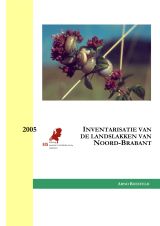 |
|
Boesveld, A., 2005.
Inventarisatie van de landslakken van Noord-Brabant
EIS 2005-02, EIS-Nederland.
Sinds 1997 wordt onder de naam van ‘Atlasproject Nederlandse Mollusken’ gewerkt aan het in kaart brengen van de verspreiding van de Nederlandse mollusken. Dit atlasproject is een samenwerkingsproject van Stichting ANEMOON en EIS-Nederland. Doel is te komen tot een verspreidingsoverzicht van de Nederlandse soorten. Van de verschillende groepen mollusken zijn de terrestrisch levende soorten, de landslakken, het slechtst onderzocht. Om dit te verbeteren is in de periode augustus 2003 tot en met juli 2004 een inventarisatie van terrestrische mollusken in Noord-Brabant uitgevoerd. De landslakkenfauna van deze provincie is de afgelopen decennia nauwelijks onderzocht en een extra inventarisatie-inspanning in deze provincie werd dringend nodig geacht.
Tijdens het veldwerk is veel aandacht uitgegaan naar soorten genoemd in de conceptnota soortenbeleid van Provincie Noord-Brabant (prioritaire soorten). Het gaat hierbij om enkele op de Rode lijst als ‘bedreigd’ of ‘ernstig bedreigd’ genoemde soorten waarvoor de provincie Noord-Brabant van groot belang is. Het betreft Zonitoides excavates, Candidula gigaxii, Helix pomatia en Vertigo substriata. De meeste aandacht is uitgegaan naar het lokaliseren van leefgebieden van Zonitoides excavatus. Het zwaartepunt van de verspreiding op het Europese vasteland ligt in Nederland waardoor ons land een internationale verantwoordelijkheid voor het behoud van de soort heeft. |
|
Downloaden |
|
|
|
|
|
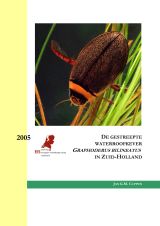 |
|
Cuppen, J.G.M., 2005.
De gestreepte waterroofkever Graphoderus bilineatus in Zuid-Holland
EIS2005-01, EIS-Nederland.
De huidige verspreiding en de biotoop van de gestreepte waterroofkever Graphoderus bilineatus in de provincie Zuid-Holland werd in 2004 onderzocht. Uitgangspunt vormden alle waarnemingen van na 1965. Op de vindplaatsen van adulten van vóór 2000 werd de soort niet meer geobserveerd. Op enkele vindplaatsen van vermeende larven van G. bilineatus werd slechts de verwante soort G. cinereusaangetroffen. Graphoderus bilineatus komt op de vindplaatsen buiten de Nieuwkoopse Plassen vrijwel zeker niet meer voor. Aan de vindplaatsen in de Nieuwkoopse Plassen, waar de soort voor het eerst in 2003 werd verzameld, konden enkele nieuwe worden toegevoegd. Toch lijkt de soort in dit natuurreservaat beperkt tot een klein gebied.
De kever leeft hier in smalle tot brede sloten en vaarten die meer dan een halve meter diep zijn en met een (slappe) veenbodem. Deze wateren staan onderling met elkaar in verbinding en hebben een vrij uniforme fysisch/chemische samenstelling. De aquatische vegetatie is vrij soortenarm en weinig ontwikkeld en is kenmerkend voor matig voedselrijk water. De waterkeverfauna bestaat opmerkelijk genoeg uit zeer algemene soorten en bevat nauwelijks kenmerkende soorten van laagveenmoerassen. De gestreepte waterroofkevers zelf worden uitsluitend aangetroffen aan de steile of zelfs ondergraven oevers van legakkers, rietkragen, veenmosrietlanden en dergelijke, vooral op kopeinden van sloten of in inhammen met een wat beter ontwikkelde vegetatie. Een zeer grove schatting van het aantal exemplaren in het gebied komt uit op 3000 exemplaren. |
|
Downloaden |
|
|
|
|
|
|
|
Krekels, R.F.M. & P.H. van Hoof, 2004
De wrattenbijter in de Overasseltse en Hatertse vennen. Monitoring 2004
EIS2004-24, Natuurbalans & EIS-Nederland. |
|
Niet openbaar |
|
|
|
|
|
|
|
Bouwman, J. & V.J. Kalkman, 2004
Tussenrapportage inhaalslag libellen
EIS2004-23. |
|
Niet openbaar |
|
|
|
|
|
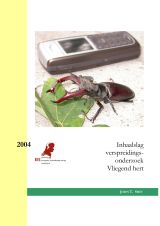 |
|
Smit, J.T., 2004.
Inhaalslag verspreidingsonderzoek vliegend hert
EIS2004-22, EIS-Nederland.
In 2004 heeft EIS-Nederland in opdracht van het Expertisecentrum van het Ministerie van Landbouw, Natuur en Voedselkwaliteit een inhaalslag uitgevoerd, waarbij de actuele verspreiding van het Vliegend hert Lucanus cervus in kaart is gebracht. Er is in 2004 groot publiciteitsoffensief rondom het vliegend hert ontketent. In totaal werden 447 persberichten verstuurd aan nationale en regionale media, 726 posters aan campings en bezoekerscentra en 20 korte artikelen voor natuurbladen. Dit bracht een vliegwieleffect teweeg. Zo verscheen de oproep ook op allerlei websites van natuurorganisaties. Dit leverde in totaal 341 waarnemingen van het vliegend hert op. De soort bleek op de Veluwe een groter verspreidingsgebied te hebben dan gedacht. De soort komt ook in het noordoosten van de Veluwe voor en ook tussen de populaties in het centrale deel van de Veluwe en de Veluwezoom zijn waarnemingen binnengekomen. Verder is de situatie ten zuiden van Nijmegen verder opgehelderd. Het gerichte veldwerk op de Utrechtse heuvelrug, op de Holterberg en bij Enschede leverde geen waarnemingen op en we concluderen dat de soort hier verdwenen is.
Het verzamelen van verspreidingsgegevens via oproepen in de media levert een redelijk betrouwbaar verspreidingsbeeld op. Hiermee is het een goed instrument om over een lange periode in kaart te brengen waar zich populaties bevinden. Door de lage standaardiseringsgraad leent de methode zich slecht voor kortetermijn-monitoring of het volgen van populatieontwikkelingen.
|
|
Downloaden |
|
|
|
|
|
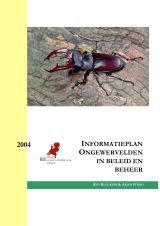 |
|
Kleukers, R.J.M. & A. Stroo, 2004.
Informatieplan Ongewervelden in beleid en beheer
EIS2004-21, EIS-Nederland.
In het informatieplan 'Ongewervelden in beleid en beheer' zijn met behulp van diverse bronnen de beleids- en beheervragen in kaart gebracht. De informatiebehoefte in het Nederlandse natuurbeleid wordt steeds sterker toegespitst op wettelijk beschermde soorten. Anderzijds zijn er diverse voorbeelden van beleidsvragen die betrekking hebben op andere ongewervelden. Enkele voorbeelden zijn: soorten die reageren op klimaatsveranderingen, aquatische organismen, invasieve soorten, schadelijke soorten en bosfauna. Dit biedt EIS-Nederland goede kansen om ongewervelden onder aandacht te blijven brengen. Het blijkt steeds moeilijker te worden om aandacht van natuurbeheerders te krijgen voor bedreigde ongewervelden die buiten wet- en regelgeving vallen. Daar komt bij dat het produceren van rapporten en plannen niet genoeg is. Persoonlijk contact met beheerders is essentieel. Indien EIS-Nederland serieus werk wil maken van bescherming van ongewervelde dieren dan zal een veel grotere inspanning nodig zijn. |
|
Downloaden |
|
|
|
|
|
|
|
Krekels, R.F.M. & P.H. van Hoof, 2004
De wrattenbijter in de Overasseltse en Hatertse vennen. Monitoring 2003
EIS2004-20, Natuurbalans & EIS-Nederland. |
|
Niet openbaar |
|
|
|
|
|
|
|
Krekels, R.F.M. & R.J.M. Kleukers, 2004
De wrattenbijter op de Veluwe. Met speciale aandacht voor Nationaal Park de Hoge Veluwe
EIS2004-19, Natuurbalans & EIS-Nederland. |
|
Niet openbaar |
|
|
|
|
|
|
|
Bouwman, J. & V.J. Kalkman, 2004
Inhaalslag habitatrichtlijnsoorten: Libellen Odonata
EIS2004-18. |
|
|
|
|
|
|
|
|
|
Kalkman, V.J., 2004b
Inhaalslag habitatrichtlijnsoorten: Europese rivierkreeft Astacus astacus
EIS2004-17. |
|
|
|
|
|
|
|
|
|
Kalkman, V.J., 2004c
Inhaalslag habitatrichtlijnsoorten: Gestreepte waterroofkever Graphoderus bilineatus
EIS2004-16. |
|
|
|
|
|
|
|
|
|
Kalkman, V.J., 2004a
Inhaalslag habitatrichtlijnsoorten: Vliegend hert Lucanus cervus
EIS2004-15. |
|
|
|
|
|
|
|
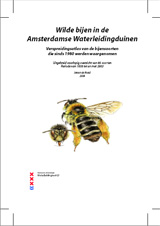 |
|
Rond, J. de, 2004
Wilde bijen in de Amsterdamse Waterleidingduinen Verspreidingsatlas van de bijensoorten die sinds 1980 werden waargenomen. Uitgebreid voorlopig overzicht van 85 soorten
EIS2004-13, Waterleidingsbedrijf Amsterdam & EIS-Nederland
Met de uitgave van een voorlopige libellenatlas in 1998 werd door Waterleidingbedrijf Amsterdam een nieuwe richting ingeslagen. Naast gewervelde dieren, planten en vlinders werd de aandacht gevestigd op dieren met een wat minder aaibaar uiterlijk. Uit de verslagen in de Nieuwsbrief Natuuronderzoek Amsterdamse Waterleidingduinen blijkt dat zich onder de inventarisatiemedewerkers binnen korte tijd een aanzienlijke kennis over, en interesse voor deze dieren heeft ontwikkeld. Met gezamenlijke inspanningen bleek niet alleen het aantal vindplaatsen van libellen in dit waterrijke duingebied toe te nemen, maar ook het aantal waargenomen soorten.
Een belangrijke aanleiding voor het kiezen van bijen als nieuw onderzoeksobject was een artikel over de bijen van de Amsterdamse Waterleidingduinen van de hand van Theo Peeters in het tijdschrift Duin. Hierin werd gewezen op de bijzondere bijenfauna van de Amsterdamse Waterleidingduinen en werd benadrukt dat extra aandacht voor deze groep in de Amsterdamse Waterleidingduinen wenselijk is. Vervolgens werd EIS-Nederland (European Invertebrate Survey) door Waterleidingbedrijf Amsterdam ingeschakeld om een bijenatlas voor de AWD samen te stellen. In deze atlas zouden een groot deel van de 119 tot nu toe bekende soorten van de AWD moeten worden besproken.
|
|
|
|
|
|
|
|
|
|
EIS-Nederland, de Vlinderstichting & de Nederlandse Vereniging voor Libellenstudie, 2004
Waarnemingenverslag ongewervelden 2004 |
|
|
|
|
|
|
|
|
|
Krekels, R.F.M. & P.H. van Hoof, 2004
De wrattenbijter in de Overasseltse en Hatertse vennen. Monitoring 2003
Natuurbalans-Limes Divergens BV & EIS Nederland. |
|
|
|
|
|
|
|
|
|
Stroo, A., 2004a
Ongewervelden in terreinen van het Zuid-Hollands Landschap. Een overzicht van de gegevens in databanken van EIS en de Vlinderstichting
EIS2004-012, De Vlinderstichting & EIS-Nederland. |
|
|
|
|
|
|
|
|
|
Stroo, A., 2004b
Ongewervelden in terreinen van het Zeeuws Landschap. Een overzicht van de gegevens in databanken van EIS en de Vlinderstichting
EIS2004-11, De Vlinderstichting & EIS-Nederland. |
|
|
|
|
|
|
|
|
|
Stroo, A., 2004c
Ongewervelden in terreinen van het Utrechts Landschap. Een overzicht van de gegevens in databanken van EIS en de Vlinderstichting
EIS2004-10, De Vlinderstichting & EIS-Nederland.
|
|
|
|
|
|
|
|
|
|
Stroo, A., 2004d
Ongewervelden in terreinen van Staatsbosbeheer. Een overzicht van de gegevens in databanken van EIS en de Vlinderstichting
EIS2004-09, De Vlinderstichting & EIS-Nederland. |
|
|
|
|
|
|
|
|
|
Stroo, A., 2004e
Ongewervelden in terreinen van het Overijssels Landschap. Een overzicht van de gegevens in databanken van EIS en de Vlinderstichting
EIS2004-08, De Vlinderstichting & EIS-Nederland. |
|
|
|
|
|
|
|
|
|
Stroo, A., 2004f
Ongewervelden in terreinen van het Noordhollands Landschap. Een overzicht van de gegevens in databanken van EIS e de Vlinderstichting
EIS2004-07, De Vlinderstichting & EIS-Nederland. |
|
|
|
|
|
|
|
|
|
Stroo, A., 2004g
Ongewervelden in terreinen van Natuurmonumenten. Een overzicht van de gegevens in databanken van EIS en de Vlinderstichting
EIS2004-06, De Vlinderstichting & EIS-Nederland. |
|
|
|
|
|
|
|
|
|
Stroo, A., 2004h
Ongewervelden in terreinen van het Limburgs Landschap. Een overzicht van de gegevens in databanken van EIS en de Vlinderstichting
EIS2004-05, De Vlinderstichting & EIS-Nederland. |
|
|
|
|
|
|
|
|
|
Stroo, A., 2004i
Ongewervelden in terreinen van It Fryske Gea. Een overzicht van de gegevens in databanken van EIS en de Vlinderstichting
EIS2004-04, De Vlinderstichting & EIS-Nederland.
|
|
|
|
|
|
|
|
|
|
Stroo, A., 2004j
Ongewervelden in terreinen van het Gronings Landschap. Een overzicht van de gegevens in databanken van EIS en de Vlinderstichting
EIS2004-03, De Vlinderstichting & EIS-Nederland.
|
|
|
|
|
|
|
|
|
|
Stroo, A., 2004k
Ongewervelden in terreinen van het Geldersch Landschap. Een overzicht van de gegevens in databanken van EIS en de Vlinderstichting
EIS2004-02, De Vlinderstichting & EIS-Nederland. |
|
|
|
|
|
|
|
|
|
Stroo, A., 2004m
Ongewervelden in terreinen van het Flevo-Landschap. Een overzicht van de gegevens in databanken van EIS en de Vlinderstichting
EIS2004-01, De Vlinderstichting & EIS-Nederland. |
|
|
|
|
|
|
|
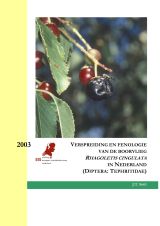 |
|
Smit, J.T., 2003
Verspreiding en fenologie van de boorvlieg Rhagoletis cingulata in Nederland (Diptera: Tephritidae)
EIS2003-13, EIS-Nederland.
In opdracht van de Plantenziektenkundige Dienst heeft EIS-Nederland van 10 juli tot en met 2 oktober 2003 een onderzoek uitgevoerd naar de verspreiding en de fenologie van de boorvlieg Rhagoletis cingulatain Nederland. Dit onderzoek concentreerde zich op Zeeland, omdat de soort daar als eerste gevonden was. Op twee locaties op Walcheren (De Zandput en het Oranjebos, bij Oranjezon) en één op Schouwen (Het Zeepe, bij Burgh) werden lijmvallen van het merk Pherocon AM (zonder lokstoffen) opgehangen. Verder werden diverse locaties met sleepnetten bemonsterd. Ook buiten de eilanden zijn verschillende locaties onderzocht. Dit onderzoek vormt een aanvulling op de landelijke inventarisatie die in 2003 is uitgevoerd door de Plantenziektenkundige Dienst, met behulp van lijmvallen. Rhagoletis cingulata is, behalve op de Zeeuwse eilanden, ook waargenomen in de Noord- en Zuid-Hollandse duinen en in Zuid Limburg. |
|
|
|
|
|
|
|
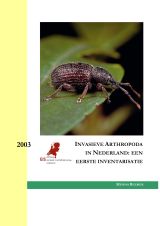 |
|
Reemer, M., 2003
Invasieve Arthropoda in Nederland: een eerste inventarisatie
EIS2003-12, EIS-Nederland.
Dit rapport presenteert een overzicht van invasieve Arthropoda (geleedpotige dieren) in Nederland. Hieronder worden soorten verstaan die zich sinds 1950 in Nederland gevestigd hebben en zich sterk hebben uitgebreid. Het overzicht kwam tot stand via een enquête onder circa 50 specialisten en beperkt zich tot de soorten waarvan het invasieve karakter duidelijk en gedocumenteerd is.
De totale lijst bevat 104 invasieve soorten Arthropoda en geeft basale informatie over het voorkomen in Nederland, biologie, ecologie en relevante literatuur. Een selectie van 33 soorten wordt uitgebreid besproken. De eerste 13 hiervan zijn sinds 1992 voor het eerst in Nederland aangetroffen. De discussie gaat in op de volledigheid van het overzicht, de herkomst en de schadelijkheid van de invasieve Arthropoda. |
|
|
|
|
|
|
|
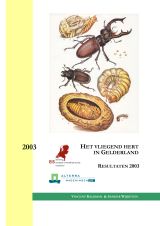 |
|
Kalkman, V. & S. Wijdeven, 2003
Het vliegend hert in Gelderland, resultaten 2003
EIS2003-11, EIS Nederland & Alterra, Wageningen UR
In 2003 is er in opdracht van provincie Gelderland en LNV door EIS-Nederland en Alterra voorbereidend onderzoek naar het vliegend hert in de provincie Gelderland uitgevoerd. Dit met als doel om meer informatie over de verspreiding en biotoopvoorkeur van de soort in de provincie Gelderland te verkrijgen. Deze gegevens moeten een basis vormen voor verder onderzoek voor een mogelijk in de toekomst op te stellen soortbeschermingsplan. De belangrijkste nieuwe informatie die het in 2003 uitgevoerde onderzoek heeft opgeleverd is:
- De soort blijkt in het ZO van de Veluwe niet verdwenen te zijn maar nog steeds in klein aantal voor te komen
- In het Rijk van Nijmegen blijkt de soort op meer plaatsen te zitten dan verwacht
- In de aan Gelderland grenzende delen van Utrecht is de soort verdwenen
- Het gericht zoeken van het Vliegend hert is te tijdrovend om als inventarisatiemethode te kunnen dienen
- Een experiment met het lokken van vliegend hert met vallen met kersen heeft geen resultaat opgeleverd
- Het door middel van oproepjes verzamelen van waarnemingen levert veel waarnemingen op waarvan de meeste op 100 bij 100 meter nauwkeurig
- De indruk ontstaat dat het vliegend hert op de Veluwe voorkeur heeft voor tegen de bosrand gelegen dorpjes. Hier zijn houtwallen en grasland (verpopping) dicht bij elkaar aanwezig. Mogelijke extra reden is de daar lagere predatie door wild zwijn
|
|
|
|
|
|
|
|
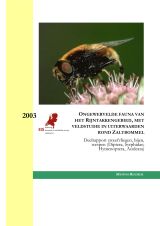 |
|
Reemer, M., 2003b
Ongewervelde fauna van het Rijntakkengebied, met veldstudie in uiterwaarden rond Zaltbommel. Deelrapport zweefvliegen, bijen en wespen (Diptera, Syrphidae; Hymenoptera, Aculeata)
EIS2003-10, EIS-Nederland.
In opdracht van Rijkswaterstaat, Directie Oost heeft EIS-Nederland in 2001 en 2002 een inventarisatie uitgevoerd van terrestrische ongewervelde dieren in vijf uiterwaarden langs de Waal rond Zaltbommel (Gelderland). Het gaat om de Breemwaard, de Gamerensche waard, de Heesseltsche waard, de Hurwenensche waard en de Rijswaard. Dit rapport behandelt de resultaten van deze inventarisatie met betrekking tot zweefvliegen (Diptera, Syrphidae), bijen (Hymenoptera, Apidae s.l.) en angeldragende wespen (Hymenoptera, Aculeata: Chrysididae, Pompilidae, Tiphiidae, Vespidae, Crabronidae, Sphecidae). Het project had als eerste doel om een referentiekader te verkrijgen voor de diversiteit van uiterwaarden van de Rijntakken. Daarnaast worden de resultaten in verband gebracht met het overstromingsregime van de rivier en worden indicatorsoorten bepaald voor biotooptypen in de uiterwaarden.
Elke uiterwaard is op zeven tot negen verschillende dagen bezocht. Per uiterwaard zijn vier tot 19 locaties bemonsterd. De insecten zijn gevangen met behulp van insectennetten. Om de resultaten in een breder kader te kunnen plaatsen, is met behulp van de landelijke databestanden van EIS-Nederland een overzicht samengesteld van de soorten die bekend zijn uit de uiterwaarden van de Nederlandse Rijntakken. Uit dit overzicht zijn de soorten bepaald met een voorkeur voor de Rijntakken. De biologische en ecologische eigenschappen van deze soorten worden vergeleken met de eigenschappen van alle Nederlandse soorten. |
|
|
|
|
|
|
|
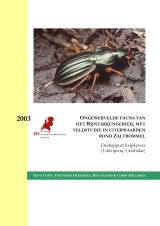 |
|
Turin, H., Th. Heijerman, K. Alders & C. Dolleman, 2003
Ongewervelde fauna van het Rijntakkengebied, met veldstudie in uiterwaarden rond Zaltbommel. Deelrapport loopkevers (Coleoptera, Carabidae)
EIS2003-09, EIS-Nederland.
In 2001 en 2002 zijn vijf uiterwaarden van de Waal rond Zaltbommel (Gelderland) geïnventariseerd op verschillende groepen ongewervelden. Deze inventarisaties zijn uitgevoerd door medewerkers van European Invertebrate Survey - Nederland (EIS-Nederland) in opdracht van Rijkswaterstaat Directie Oost-Nederland. Een overkoepelend verslag van dit onderzoek wordt gepresenteerd in Kalkman et al. (2003). Hierin worden ook algemene gebiedsomschrijvingen gegeven. Deelverslagen over de afzonderlijke onderzochte groepen zijn gepubliceerd in De Bruyne et al. (2003), Van Helsdingen (2003), Kalkman (2002, 2003), Reemer (2003). Dit rapport behandelt de resultaten van het onderzoek aan loopkevers (Carabidae).
Het doel van de inventarisaties was in eerste instantie het verkrijgen van een overzicht van de diversiteit van de onderzochte groepen in uiterwaarden die representatief zijn voor het betreffende stroomtraject van de Rijntakken. De aandacht ging met name uit naar graslanden en ruigten. Ooibossen zijn grotendeels buiten beschouwing gebleven. De resultaten van de inventarisaties zijn beschouwd in het kader van de fauna van de Rijntakken, zoals gedefinieerd door Rijkswaterstaat. Deze karakteristieke fauna van de Rijntakken is bepaald met behulp van faunagegevens uit de databank van EIS-Nederland.
|
|
|
|
|
|
|
|
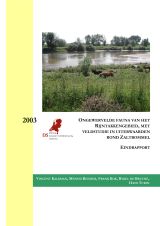 |
|
Kalkman, V.J., M. Reemer, R.H. Bruyne & H. Turin, 2003
Ongewervelde fauna van het Rijntakkengebied, met veldstudie in uiterwaarden rond Zaltbommel. Eindrapport
EIS2003-08, EIS-Nederland.
Voor de aquatische fauna en flora van uiterwaarden is het mogelijk om veel van de gevonden diversiteitspatronen te verklaren door verschillen in intensiteit en duur van het contact van de biotoop met de rivier. Het is duidelijk dat de terrestrische fauna eveneens voor een groot deel door het rivierregime bepaald wordt. Over de mate waarin dit het geval is en over hoe sterk dit per diergroep verschilt is weinig concrete informatie beschikbaar. Ook is het niet duidelijk voor welke groepen de overstromingen verrijkend werken en voor welke groepen de overstromingen juist beperkend zijn. In door RIZA geïnitieerd onderzoek werd voor het eerst in Nederland grootschalig gekeken naar de invloed van ontkleiïng op de ongewervelde fauna. Hieruit bleek dat verlaging van de uiterwaarden ten opzichte van de rivier positief uitpakt voor veel typische soorten van het rivierengebied. Om meer kennis te verwerven over de ongewerveldenfauna van het rivierengebied is in 2001 door Rijkswaterstaat directie Oost-Nederland een project opgestart met als doel meer inzicht te krijgen in de invloed van het rivierregime op de samenstelling van de uiterwaardenfauna. Het voorliggende rapport geeft een samenvatting van de resultaten van dit project. |
|
|
|
|
|
|
|
 |
|
Kalkman, V.J., 2003
Ongewervelde fauna van het Rijntakkengebied, met veldstudie in uiterwaarden rond Zaltbommel. Deelrapport libellen (Odonata)
EIS2003-07, EIS-Nederland.
In opdracht van Rijkswaterstaat, Directie Oost heeft EIS-Nederland in 2001 en 2002 een inventarisatie uitgevoerd van terrestrische ongewervelde dieren in vijf uiterwaarden langs de Waal rond Zaltbommel (Gelderland). Het gaat om de Breemwaard, de Gamerensche waard, de Heesseltsche waard, de Hurwenensche waard en de Rijswaard. Dit rapport behandelt de resultaten van deze inventarisatie met betrekking tot libellen (Odonata). Het project had als eerste doel om een referentiekader te verkrijgen voor de diversiteit van uiterwaarden van de Rijntakken. Daarnaast worden de resultaten in verband gebracht met het overstromingsregime van de rivier en worden indicatorsoorten bepaald voor biotooptypen in de uiterwaarden.
Elke uiterwaard is zowel in 2001 als in 2002 twee keer onderzocht op het voorkomen van libellen. Daarnaast is elk kribvak tijdens veldwerk aan de ecologie van de rivierrombout Gomphus flavipes specifiek onderzocht op het voorkomen van deze soort. Om de resultaten in een breder kader te kunnen plaatsen, is met behulp van het landelijk libellenbestand NVL/De Vlinderstichting/EIS-Nederland een overzicht samengesteld van de soorten die bekend zijn uit de uiterwaarden van de Nederlandse Rijntakken. Aan de hand van dit overzicht zijn de soorten bepaald met een voorkeur voor de Rijntakken. |
|
|
|
|
|
|
|
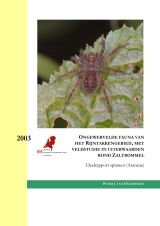 |
|
Helsdingen, P.J., 2003
Ongewervelde fauna van het Rijntakkengebied, met veldstudie in uiterwaarden rond Zaltbommel. Deelrapport spinnen (Arachnida, Aranae)
EIS2003-06, EIS-Nederland.
In opdracht van Rijkswaterstaat, Directie Oost-Nederland, heeft de European Invertebrate Survey - Nederland in 2001 en 2002 een inventarisatie van de fauna van ongewervelden verricht in zes uiterwaarden langs de Waal rond Zaltbommel. De onderzochte uiterwaarden zijn de Hurwenensche waard, Gamerensche waard, Breemwaard, Rijswaard, Heesseltsche waard en Stiftsche waard. Het doel van dit rapport is het verschaffen van een referentiekader voor de diversiteit in soorten en biotopen in de uiterwaarden van de Rijntakken en deze te relateren aan het overstromingsregime van de rivier. Er werden waar mogelijk indicatorsoorten bepaald voor de verschillende biotooptypen in de uiterwaarden. De inventarisatie werd uitgevoerd met behulp van vangpotten, welke in raaien van vijf potten werden ingegraven op de onderscheiden biotopen in alle genoemde uiterwaarden. In totaal werden op deze wijze 29 plaatsen bemonsterd. De hier gerapporteerde vangsten worden vergeleken met eerder gepubliceerde gegevens over het voorkomen van spinnen langs de Rijntakken. Hieruit resulteert een overzicht van spinnensoorten die in ons land een voorkeur hebben voor de Rijntakken dan wel altijd in uiterwaarden langs de Rijntakken worden aangetroffen. |
|
|
|
|
|
|
|
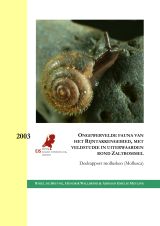 |
|
Bruyne, R., H. Wallbrink & A.W. Gmelig Meyling, 2003
Ongewervelde fauna van het Rijntakkengebied, met veldstudie in uiterwaarden rond Zaltbommel. Deelrapport Mollusken (Mollusca)
EIS2003-05, EIS-Nederland.
In 2001 en 2002 is in opdracht van Rijkswaterstaat, Directie Oost, door EIS-Nederland en stichting Anemoon een inventarisatie uitgevoerd naar het voorkomen van terrestrische mollusken (landslakken) in een vijftal uiterwaarden van de Waal nabij Zaltbommel. Het betreft locaties aan de oostkant (noord- en zuid-oever) en de westkant (zuid-oever) in de Breemwaard, Gamerensche waard, Heesseltsche waard, Hurwenensche waard en Rijswaard. Doel van het onderzoek was om meer inzicht te krijgen in de indicatorwaarde van ongewervelden in de uiterwaarden. Naast het onderzoek naar mollusken, zijn in dezelfde periode inventarisaties uitgevoerd gericht op loopkevers, sprinkhanen, libellen, bijen, wespen, zweefvliegen en spinnen. Er is voornamelijk gekeken naar landbewonende mollusken (Gastropoda, Pulmonata). Zoetwatermollusken (Gastropoda, Bivalvia) werden alleen bij de inventarisaties betrokken wanneer ze levend werden aangetroffen in dezelfde biotoop (met name in bodemmonsters). |
|
|
|
|
|
|
|
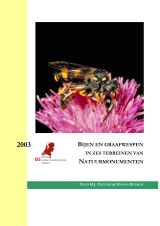 |
|
Peeters, T.M.J. & M. Reemer, 2003
Bijen en graafwespen in zes terreinen van Natuurmonumenten
EIS2003-04, EIS-Nederland.
In 2002 verrichtten medewerkers van EIS-Nederland veldonderzoek naar de bijen- en graafwespenfauna in zes terreinen van de Vereniging Natuurmonumenten: de Kampina, de Maasuiterwaarden bij Den Bosch, Planken Wambuis, de Plateaux, Voornes Duin en de Zeepeduinen.
In dit rapport worden de resultaten van deze inventarisaties besproken. Ook is er aandacht voor gegevens van bijen en graafwespen uit eerdere jaren, voor zover deze aanwezig zijn in de databestanden van EIS-Nederland. Aan de hand hiervan worden beheeraanbevelingen gedaan ten behoeve van de bijen- en graafwespenfauna. In de inleiding worden enkele algemene richtlijnen gegeven voor bijen- en graafwespenvriendelijk beheer van natuurgebieden. |
|
|
|
|
|
|
|
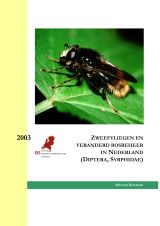 |
|
Reemer, M., 2003c
Zweefvliegen van veranderd bosbeheer in Nederland (Diptera, Syrphidae)
EIS2003-01, EIS-Nederland.
In de afgelopen 20 jaar is het Nederlandse natuurbeheer zich meer gaan richten op een natuurlijke ontwikkeling van bossen. Hierin staan het streven naar meer structuurvariatie en het bevorderen van natuurlijke processen centraal. Een belangrijk aspect hiervan is het laten liggen van dood hout. In dit rapport wordt onderzocht wat de invloed is van het veranderde bosbeheer op de Nederlandse zweefvliegenfauna. Speciale aandacht gaat hierbij uit naar de zweefvliegsoorten waarvan de larven geassocieerd zijn met oude bomen of dood hout, de zogenaamde ‘saproxylische’ soorten. In Nederland komen 58 zweefvliegsoorten voor met een dergelijke levenswijze.
Het onderzoek is uitgevoerd met behulp van de Databank Nederlandse Zweefvliegen (EIS-Nederland, NJN, Sectie Diptera NEV). Dit databestand bevat circa 260.000 gegevens van zweefvliegen in Nederland. Voor elke zweefvliegensoort is een trend berekend aan de hand van het voorkomen voor 1988 en vanaf 1988. Uit de resultaten blijkt dat zweefvliegsoorten van bossen sterker toenemen dan soorten die niet in bossen voorkomen. Deze toename wordt met name veroorzaakt door de sterke toename van saproxylische soorten. Van de saproxylische soorten is 59% vooruitgegaan, terwijl dit bij de niet-saproxylische soorten 34% is. |
|
|
|
|
|
|
|
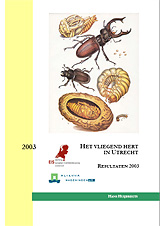
|
|
Huijbregts, H., 2003
Het vliegend hert in Utrecht. Resultaten 2003
EIS2003-01, EIS Nederland & Alterra, Wageningen UR
Van oudsher zijn er meldingen van het vliegend hert uit de provincie Utrecht. Door Van Laar werden de aan hem in 1987 bekende waarnemingen samengevat. Om de huidige status het vliegend hert in de provincie Utrecht vast te stellen werd door EIS-Nederland, in opdracht van de provincie Utrecht, in de zomer van 2003 onderzoek naar het voorkomen in de regio Amersfoort uitgevoerd.
Het onderzoek heeft geen bevestiging opgeleverd over de huidige aanwezigheid van het vliegend hert in de provincie Utrecht. Het lijkt dan ook het beste om de soort in het beleid voorlopig als 'mogelijk aanwezig' te beschouwen. Het is zaak om snel te reageren op eventuele nieuwe waarnemingen zodat de betrouwbaarheid gelijk gecontroleerd kan worden. Eventueel verder veldwerk zou zich moeten concentreren op enkele defensieterreinen. Gezien de waarschijnlijk lage dichtheid is het trachten aan te lokken van vliegende herten waarschijnlijk de beste methode om waarnemingen te verzamelen. Daarnaast is het van belang om bij defensiepersoneel aandacht te vragen voor de soort. De defensieorganisatie is geïnteresseerd in eventuele specifieke beheersmaatregelen en staat niet onwelwillend tegen verder onderzoek. |
|
|
|
|
|
|
|
|
|
Krekels, R.F.M., 2003
De wrattenbijter in de Overasseltse en Hatertse vennen. Monitoring 2002
Natuurbalans-Limes Divergens BV & EIS Nederland.
|
|
|
|
|
|
|
|
|
|
EIS Nederland, de Vlinderstichting & de Nederlandse Vereniging voor Libellenstudie, 2003
Waarnemingenverslag dagvlinders, libellen en sprinkhanen 2003 |
|
|
|
|
|
|
|
|
|
Boeren, J., H. van Buggenum, J. Hermans, W. Jansen, R. Kleukers & H. van Kuijk, 2003
Werkatlas Sprinkhanen en krekels van Limburg
Natuurhistorisch Genootschap & EIS Nederland.
|
|
|
|
|
|
|
|
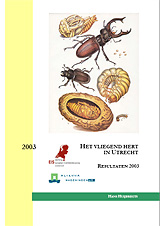 |
|
Huijbregts, H., 2002
Het vliegend hert - een bureaustudie
EIS2002-07, EIS-Nederland.
In Noordoost Twente komt, als één van de weinige plekken in Nederland, het vliegend hert voor. Deze populatie moet, gezien de zeldzaamheid van de soort en het feit dat zij valt onder de habitatrichtlijn, beschermd en voor de toekomst behouden worden. In het betreffende gebied komt veel eikenhakhout voor dat lange tijd niet is afgezet. De kans bestaat dat het langdurig achterwege blijven van het hakhoutbeheer op de langere duur negatieve gevolgen heeft voor het vliegend hert. Daarnaast is het uit ecologisch en landschappelijk oogpunt gewenst om de houtopstanden weer actief te gaan beheren. Om dit op een verantwoorde manier te kunnen doen is gedetailleerde informatie over het vliegend hert noodzakelijk. Het voorliggend rapport bevat een compilatie van literatuurkennis en collectiegegevens van het vliegend hert in Nederland. |
|
|
|
|
|
|
|
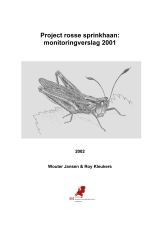 |
|
Jansen, W. & R. Kleukers, 2002
Project rosse sprinkhaan: monitoringverslag 2001
EIS2002-05, EIS-Nederland.
In 2001 werd voor het vierde achtereenvolgende jaar de populatiedichtheid van de rosse sprinkhaan bij Schin op Geul bepaald. Er werd het hoogste aantal rosse sprinkhanen tot nu toe geteld. Op 14 augustus werden 127 zingende mannetjes gehoord op traject A, de hoofdpopulatie. De populatiedichtheid voor 2001 wordt daarmee voor het eerst op meer dan 1000 individuen geschat. Er liggen diverse voorstellen voor het verder uitbreiden van het leefgebied van de rosse sprinkhaan. Hiervan is het geëxtensiveerd maaibeheer van de bermen van traject A en het uitrasteren van een strook van het grasland van Natuurmonumenten inmiddels doorgevoerd. Voor de overige voorstellen wordt nog financiering gezocht.
De populatie lijkt momenteel niet bedreigd. We stellen daarom voor om ingaande per 2002 slechts een minimale telling te verrichten. Hierbij wordt op één dag (in de periode 5-25 augustus) een telling van traject A uitgevoerd, plus een snelle inventarisatie van de andere deelpopulaties. De rapportage is beknopt en bestaat uit de veldformulieren, met een samenvatting waarin een grove populatieomvang wordt bepaald, met een korte toelichting. Eens in de vijf jaar zal een uitgebreide telling worden verricht, conform de jaren 1999, 2000 en 2001. |
|
|
|
|
|
|
|
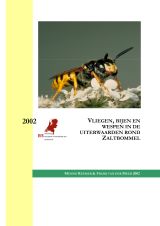 |
|
Reemer, M. & F. van der Meer, 2002
Vliegen, bijen en wespen in de uiterwaarden rond Zaltbommel
EIS2002-04, EIS-Nederland.
In opdracht van Rijkswaterstaat, Directie Oost, werd door EIS-Nederland in 2001 een inventarisatie verricht in vijf uiterwaarden langs de Waal ten oosten (rechter- en linkeroever) en westen (linker-oever) van Zaltbommel. Deze inventarisatie dient als basis voor verder onderzoek naar de indicatorwaarde van ongewervelden in de uiterwaarden. De inventarisatie richtte zich op sprinkhanen, libellen, bijen, wespen, zweefvliegen en spinnen. In dit rapport worden de resultaten met betrekking tot de bijen, wespen en zweefvliegen behandeld.
De onderzochte gebieden zijn de Breemwaard, de Gamerensche waard, de Heesseltsche waard, de Hurwenensche waard en de Rijswaard. Deze vijf uiterwaarden zijn geïnventariseerd op de volgende families: zweefvliegen (Syrphidae), bijen (Apidae), graafwespen (Crabronidae & Sphecidae), spinnendoders (Pompilidae), plooivleugelwespen (Vespidae), keverdoders (Tiphiidae) en goudwespen (Chrysididae). Blaaskopvliegen (Conopidae), boorvliegen (Tephritidae), dazen (Tabanidae), prachtvliegen (Otitidae), roofvliegen (Asilidae), sluipvliegen (Tachinidae) viltvliegen (Therevidae) en wapenvliegen (Stratiomyidae) zijn in beperkte mate verzameld. Dit verslag bespreekt de aangetroffen fauna.
|
|
|
|
|
|
|
|
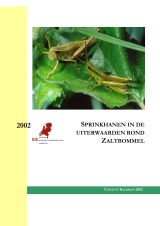 |
|
Kalkman, V.J., 2002
Sprinkhanen in de uiterwaarden rond Zaltbommel
EIS2002-03, EIS-Nederland.
In opdracht van Rijkswaterstaat, Directie Oost, werd door EIS-Nederland in 2001 een inventarisatie verricht in vijf uiterwaarden langs de Waal ten oosten (rechter- en linkeroever) en westen (linker-oever) van Zaltbommel. Deze inventarisatie dient mogelijk als basis voor verder onderzoek naar de indicatorwaarde van ongewervelden in de uiterwaarden.
De inventarisatie richtte zich op sprinkhanen, libellen, bijen, wespen, zweefvliegen en spinnen. In dit rapport worden de resultaten met betrekking tot de sprinkhanen behandeld. Van de negen in het Nederlandse uiterwaardengebied algemene soorten werden er acht aangetroffen. Twee Nederlandse soorten, de bramensprinkhaan Pholidoptera griseoaptera en het kalkdoorntje Tetrix tenuicornis, hebben een belangrijk deel van hun areaal in het uiterwaardengebied. De bramesprinkhaan is algemeen in alle onderzochte uiterwaarden aangetroffen. Het kalkdoorntje is in 1994 bij de spoordijk bij Zaltbommel gevonden maar is bij de huidige inventarisaties niet aangetroffen. Op de gouden sprinkhaan Chrysochraon dispar na zijn alle aangetroffen soorten algemeen in Nederland. De gouden sprinkhaan is vrij zeldzaam en staat op de Rode lijst als kwetsbaar. De precieze biotoop van deze soort in de uiterwaarden is niet bekend. Wel lijkt het erop dat deze soort in de uiterwaarden veel drogere biotopen prefereert dan in de rest van Nederland. |
|
|
|
|
|
|
|
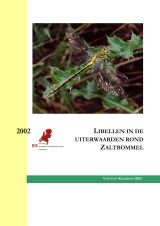 |
|
Kalkman, V.J., 2002b
Libellen in de uiterwaarden rond Zaltbommel
EIS2002-02, EIS-Nederland.
In opdracht van Rijkswaterstaat, Directie Oost, werd door EIS-Nederland in 2001 een inventarisatie verricht in vijf uiterwaarden langs de Waal ten oosten (rechter- en linkeroever) en westen (linker-oever) van Zaltbommel. Deze inventarisatie dient als basis voor verder onderzoek naar de indicatorwaarde van ongewervelden in de uiterwaarden. De inventarisatie richtte zich op sprinkhanen, libellen, bijen, wespen, zweefvliegen en spinnen. In dit rapport worden de resultaten met betrekking tot de libellen behandeld.
De tijdens dit onderzoek geïnventariseerde uiterwaarden betreffen de Breemwaard, Gamerensche waard, Heesseltsche waard, Hurwenensche waard en de Rijswaard. In totaal werden 23 soorten libellen waargenomen waarvan drie soorten die gebonden zijn aan stromend water. Hiervan is alleen de rivierrombout Gomphus flavipes strikt gebonden aan rivieren. De soorten die bij de stilstaande wateren in de uiterwaarden werden aangetroffen betreffen allemaal in Nederland algemene soorten die een weinig stringente biotoopvoorkeur hebben.
|
|
|
|
|
|
|
|
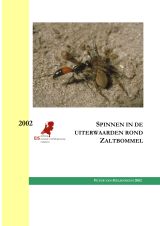 |
|
Helsdingen, P. van, 2002
Spinnen in de uiterwaarden rond Zaltbommel
EIS2002-01, EIS-Nederland.
In opdracht van Rijkswaterstaat, Directie Oost, werd door EIS-Nederland in 2001 een inventarisatie verricht in vijf uiterwaarden langs de Waal ten oosten (rechter- en linkeroever) en westen (linker-oever) van Zaltbommel. Deze inventarisatie dient als basis voor verder onderzoek naar de indicatorwaarde van ongewervelden in de uiterwaarden. De inventarisatie richtte zich op sprinkhanen, libellen, bijen, wespen, zweefvliegen en spinnen. In dit rapport worden de resultaten met betrekking tot de spinnen behandeld.
De samenstelling van de spinnenfauna van de vijf uiterwaarden werd bestudeerd aan de hand van vangsten met vangpotjes. De veldperiode was beperkt tot de maanden augustus en september (2001). In totaal werden 3419 exemplaren gevangen en gedetermineerd en 45 soorten uit zeven families vastgesteld. Dit is aanzienlijk minder dan in vergelijkbare onderzoeken elders in Nederland en in het buitenland Er werden diverse soorten aangetroffen, die kenmerkend zijn voor riviersystemen. Zoals gebruikelijk maakten enkele soorten, die bekend staan als "verstoringsspinnen", meer dan de helft uit van het aantal gevangen exemplaren. Dit is een gevolg van het dynamische milieu in uiterwaarden. Verwacht wordt dat een in de tijd uitgebreider onderzoek met vangpotjes zowel als handvangsten een groter aantal soorten aan het licht zal brengen. |
|
|
|
|
|
|
|
|
|
Krekels, R.F.M., R.M.J.C. Kleukers & P.J.M. Verbeek, 2002
De wrattenbijter in de Overasseltse en Hatertse vennen. Maatregelen voor duurzaam behoud van een kwetsbare populatie
Natuurbalans-Limes Divergens BV & EIS Nederland.
|
|
|
|
|
|
|
|
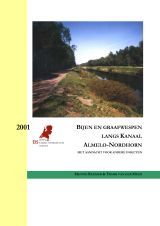 |
|
Reemer, M. & F. van der Meer, 2001
Bijen en graafwespen langs kanaal Almelo-Nordhorn, met aandacht voor andere insecten
EIS2001-04, EIS-Nederland.
In 2001 hebben medewerkers van EIS-Nederland in opdracht van de Provincie Overijssel een inventarisatie uitgevoerd van de bijen- en graafwespenfauna van Kanaal Almelo-Nordhorn. Er zijn 56 soorten bijen en 26 soorten graafwespen gevonden. Hieronder zijn twee bijzondere bijen (Andrena gravida en Lasioglossum fratellum) en drie bijzondere graafwespen (Ectemnius lituratus, Mimesa bruxellensis en Mimumesa beaumonti). In dit rapport worden deze resultaten besproken en gaat tevens aandacht uit naar het voorkomen van enkele andere bijzondere insecten langs dit kanaal. Met name het voorkomen van enkele zeldzame sprinkhanen is vermeldenswaardig: het zoemertje Stenobothrus lineatus, het schavertje Stenobothrus stigmaticus, de zompsprinkhaan Chorthippus montanus en de weidesprinkhaan Chorthippus dorsatus. Verder wordt kort ingegaan op enkele soorten libellen, zweefvliegen en langsprietmotten. Naar aanleiding van de resultaten worden aanbevelingen gegeven voor het beheer van de kanaaltaluds. |
|
|
|
|
|
|
|
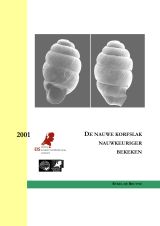 |
|
de Bruyne, R.H., 2001
De nauwe korfslak nauwkeuriger bekeken
EIS2001-03, EIS-Nederland.
In juni en juli 2001 werd een gerichte inventarisatie van de nauwe korfslak in de Zuid-Hollandse duingebieden uitgevoerd. Het onderzoek gebeurde in opdracht van de Provincie Zuid-Holland en het Expertisecentrum PMR. De nauwe korfslak is vroeger op relatief veel plaatsen in het Nederlandse duingebied gevonden en verspreid in het binnenland. Recent is de soort slechts op een zeer klein aantal plaatsen aangetroffen. Met het in dit rapport gepresenteerde onderzoek wordt een bijdrage geleverd aan de kennis over de verspreiding van de nauwe korfslak in de Zuid-Hollandse duingebieden. Een actuele aanleiding voor dit onderzoek vormde de keuze voor gebieden waar natuurcompensatie kan plaatsvinden in het kader van de aanleg van de 2e Maasvlakte.
Tijdens het onderzoek werden zoveel mogelijk oude vindplaatsen in het Zuid-Hollandse duingebied bezocht, om te bezien of de soort er nog voorkomt. In totaal werden 56 locaties in 37 kilometerhokken bezocht, verspreid over zeven duingebieden: Goeree, Voorne, Maasvlakte e.o., Hoek van Holland e.o., Meijendel, Berkheide, Amsterdamse Waterleidingduinen (AWD). Vertigo angustior werd in alle duingebieden, behalve bij Hoek van Holland, aangetroffen, in totaal op 12 locaties (10 kilometerhokken): Voorne (vier), omgeving van de Maasvlakte (twee populaties, waaronder de Brielse Gatdam), Meijendel (één), Berkheide (één) en Amsterdamse Waterleidingduinen (twee). Op de locatie Arendsduin/Banken werd V. angustior niet aangetroffen. Op Goeree werden geen levende dieren aangetroffen, wel oude en verse schelpen, ieder op een locatie. In dit rapport worden de resultaten uit dit onderzoek toegelicht. |
|
|
|
|
|
|
|
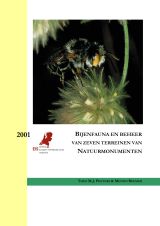 |
|
Peeters, Th.M.J. & M. Reemer, 2001
Bijenfauna en beheer van zeven terreinen van Natuurmonumenten
EIS2001-02, EIS-Nederland.
In 1999 en 2000 verrichtten medewerkers van EIS-Nederland veldonderzoek naar de wilde bijenfauna in zeven terreinen van Natuurmonumenten: het Dwingelderveld, Huis ter Heide, het Korenburgerveen, de Loonse en Drunense duinen, het Naardermeer, groeve Sweijer en Nationaal Park Zuid-Kennemerland. De resultaten van deze inventarisaties worden in dit rapport per terrein besproken en aan de hand hiervan worden beheersaanbevelingen gedaan ten behoeve van de bijenfauna.
De inleiding besteedt aandacht aan algemene beheersmaatregelen ten behoeve van de bijenfauna. Het afsluitende hoofdstuk geeft een overzicht van de gevonden aantallen soorten in de terreinen, zowel voor de periode tot en met 1998 als de inventarisaties in 1999 en 2000. Hierbij gaat ook aandacht uit naar het aandeel bedreigde soorten in de gebieden. |
|
|
|
|
|
|
|
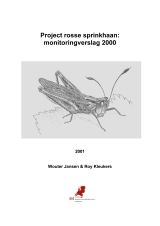 |
|
Jansen, W. & R. Kleukers, 2001
Project rosse sprinkhaan: monitoringverslag 2000
EIS2001-01, EIS-Nederland.
In 2000 werd voor het derde achtereenvolgende jaar de populatiedichtheid van de rosse sprinkhaan bij Schin-op-Geul bepaald. De populatiedichtheid voor 2000 wordt, net als voor 1999, geschat op 600-800 dieren. Om het leefgebied van de rosse sprinkhaan verder te vergroten worden de volgende aanbevelingen gedaan:
Fasering van het maaibeheer van het grasland van Natuurmonumenten. Dit perceel is waarschijnlijk het belangrijkste potentieel nieuwe leefgebied. Het grasland wordt sinds 2000 niet meer begraasd, maar gemaaid. Dat de rosse sprinkhaan hier nog niet gevonden is, komt waarschijnlijk door de manier van maaien; integraal en te vroeg. In figuur 4 wordt een maaischema voor het grasland voorgesteld.
- Openkappen van een strook aan de zuidzijde van het spoor.
- Aankoop van een aantal terreinen ten noorden van het spoor. De belangrijkste is de akker, grenzend aan het grasland van Natuurmonumenten. Daarnaast zijn er een aantal kleinere extensief beheerde percelen die wat verder van de populatie verwijderd zijn.
- Er is getracht een relatie te vinden tussen verschillende maai-jaren en de aantallen waargenomen rosse sprinkhanen. De hoogste aantallen worden in vakken die nog niet gemaaid zijn. Er werd echter geen relatie gevonden met het laatste jaar van maaien. De interpretatie van de gegevens werd bemoeilijkt door een aantal methodologische problemen. Momenteel lijkt de populatie niet bedreigd. Het voorstel is om in 2001 en 2002 nog een zelfde telling uit te voeren en daarna met tussenpozen van 5 jaar een volledige telling uit te voeren. In de tussenjaren wordt met minimale inspanning een populatieschatting gemaakt.
|
|
|
|
|
|
|
|
 |
|
Jansen, W. & R. Kleukers, 2000
Project rosse sprinkhaan: monitoringverslag 1999
EIS2000-03,
In 1999 werd middels een gestandaardiseerde telling de populatiedichtheid van de rosse sprinkhaan bij Schin-op-Geul bepaald. De populatiedichtheid wordt geschat op 600-800 dieren. Dit is veel hoger dan de hoogste schatting tot nu toe, 200-300 dieren. Het lijkt er op dat de rosse sprinkhaan goed reageert op de speciale maatregelen die genomen worden om het leefgebied te verbeteren. In 1997 werd een 15 meter brede strook van een weiland van Natuurmonumenten uitgerasterd. Hier is de vegetatie duidelijk verruigd en in 1999 is de rosse sprinkhaan hier voor de eerste maal aangetroffen. |
|
|
|
|
|
|
|
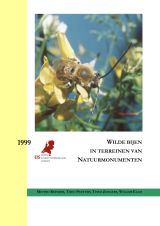 |
|
Reemer, M., Th. Peeters, Th. Zeegers & W. Ellis, 1999
Wilde bijen in terreinen van Natuurmonumenten
EIS1999-03, EIS-Nederland.
Er zijn sterke aanwijzingen dat het plaatsen van bijenkasten in natuurgebieden negatief kan zijn voor de plaatselijke wilde-bijenfauna. De honingbij concurreert met wilde bijen om stuifmeel, waardoor de broedzorg van sommige soorten nadeel ondervindt. Dit was voor Natuurmonumenten de aanleiding om EIS-Nederland te verzoeken een rapport op te stellen over de bijen van hun terreinen en advies uit te brengen over beschermingsmaatregelen voor de bijenfauna.
Door het EIS-waarnemingenbestand van de wilde bijen te koppelen aan het gebiedenbestand van Natuurmonumenten konden de gegevens van bedreigde bijensoorten geselecteerd worden. Uit 107 van de circa 360 gebieden zijn gegevens van bedreigde bijen bekend. Er werd een lijst samengesteld van gebieden met de meeste bedreigde soorten in de afgelopen eeuw, en tevens een lijst van gebieden met de meeste bedreigde soorten vanaf 1980. Met behulp van gegevens over bloembezoek is onderzocht welke planten belangrijk zijn voor de voedselvoorziening van bijen. Naast enkele algemeen voorkomende families (composieten, schermbloemigen, kruisbloemigen, vlinderbloemigen en lipbloemigen) bleken vooral de volgende plantensoorten en –genera van belang: klokjes, Centaurea-soorten, slangenkruid, zandblauwtje, rolklaver, ganzerik, braam, wilg, paardenbloem en klaver. Tot slot wordt advies uitgebracht ten aanzien van het beheer in gebieden met een bijzondere bijenfauna en worden er lijsten gegeven van gebieden waarvoor het interessant zou zijn om de huidige bijenfauna beter te onderzoeken.
|
|
|
|
|
|
|
|
|
|
R. Krekels, P. Verbeek & R.M.J.C. Kleukers, 1999
De wrattenbijter langs het Drongelens kanaal. Duurzaam behoud van de wrattenbijter en zijn leefgebied
Natuurbalans-Limes Divergens BV & EIS Nederland. |
|
|
|
|
|
|
|
|
|
Jansen, W., R. Kleukers & B. Odé, 1999
De rosse sprinkhaan bij Schin-op-Geul
EIS1999-01. |
|
|
|
|
|
|
|
|
|
Reemer, M. & V.J. Kalkman, 1998
Sprinkhanen en krekels van de Rode lijst in Gelderland |
|
|
|
|
|
|
|
|
|
Kalkman, V.J., R. Ketelaar & M. Reemer 1998
Libellen van de Rode lijst in Gelderland |
|
|
|
|
|
|
|
|
|
Stroo, A., 1997
Verspreidingsanalyse doelsoorten libellen |
|
|
|
|
|
|
|
|
|
Kleukers, R. & A. Stroo 1997
Het belang van het buitendijks gebied van Tolkamer tot Kandia voor libellen en sprinkhanen
|
|
|
|
|
|
|
|
|
|
De Vlinderstichting 1992
De dagvlinders van het Drongelens kanaal, inventarisatie 1991 en analyse historische gegevens. Deelrapport bij: De fauna van het Drongelens kanaal |
|
|
|
|
|
|
|
|
|
Peeters, Th.M.J., 1992
De bijen en wespen van het Drongelens kanaal. Deelrapport bij: De fauna van het Drongelens kanaal
|
|
|
|
|
|
|
|
|
|
Musters, J.C.M., 1992
De sprinkhanen en krekels van het Drongelens kanaal. Deelrapport bij: De fauna van het Drongelens kanaal |
|
|
|
|
|
|
|
|
|
Moller Pillot, H. 1992
De fauna van het Drongelens kanaal. Bestaande gegevens, natuurwaarde en betekenis hiervan voor de inrichting
Oekologisch Adviesbureau Moller Pillot, EIS Nederland & De Vlinderstichting. |
|
|








































































































